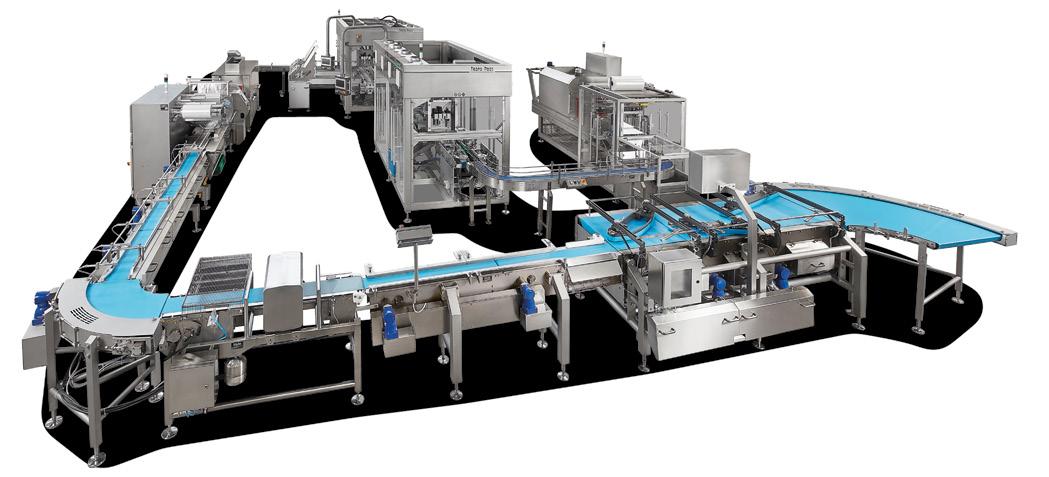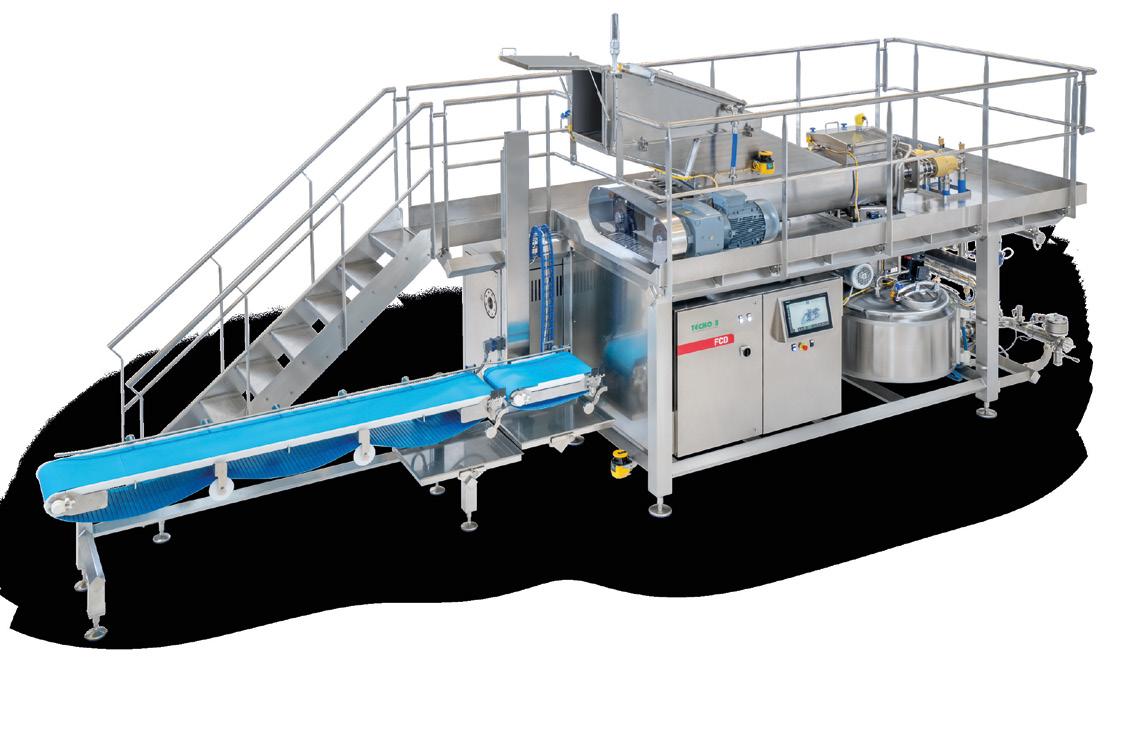


10064 PINEROLO - ITALIA Tel. +39 0121393127 - Fax +39 0121794480 info@chiriottieditori.it - www.foodexecutive.com Supplemento al n. 3, marzo 2020 di Industrie AlimentariSped. in A.P.D.L. 353/2003 (Conv. in L. 27/02/2004 n° 46) art. 1 comma 1 DCB TOn. 01 anno 2020IP n. 94 - March 2020 ISSN 1590-6515 FOOD & PACKAGING TECHNOLOGY ITALIAN +39 0173 61.05.64 • www.tecno-3.it Headquarter: Tecno 3 S.r.l. - Corneliano d’Alba - ITALY Tecno 3 Switzerland Tecno 3 USA INC FCD CONTINUOUS MELTING, IN A SINGLE PLANT AND IN A SMALL SPACE COCOA AND CHOCOLATE MASS IN BLOCKS BLOCKS OF FAT, ANHYDROUS AND HYDRATED BUTTER 10064 PINEROLO - ITALIA Tel. +39 0121393127 info@chiriottieditori.it www.foodexecutive.com 03, marzo 2024 di Industrie AlimentariSped. in A.P.D.L. 353/2003 (Conv. in L. 27/02/2004 n° 46) art. 1 comma 1 DCB TOn. 106 anno 2024IP n. 106 FOOD & PACKAGING TECHNOLOGY
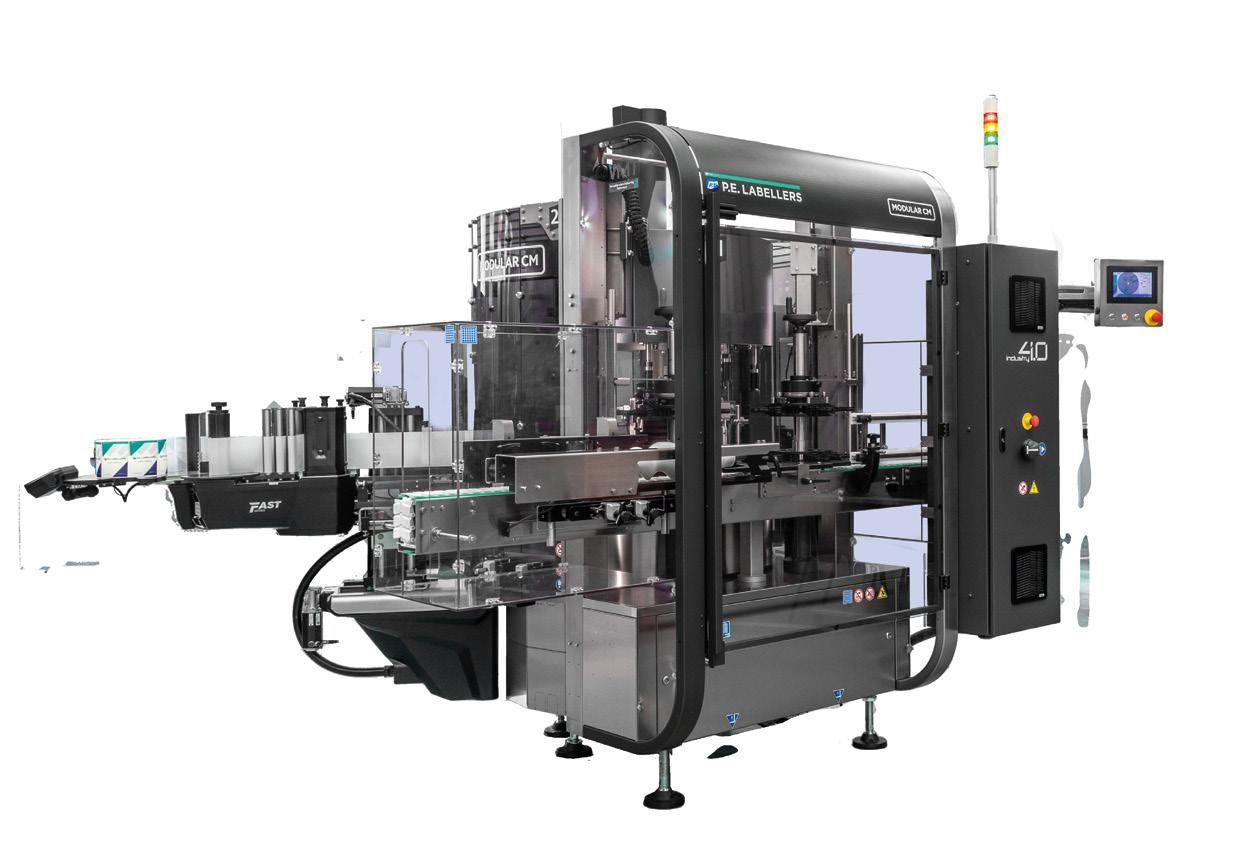
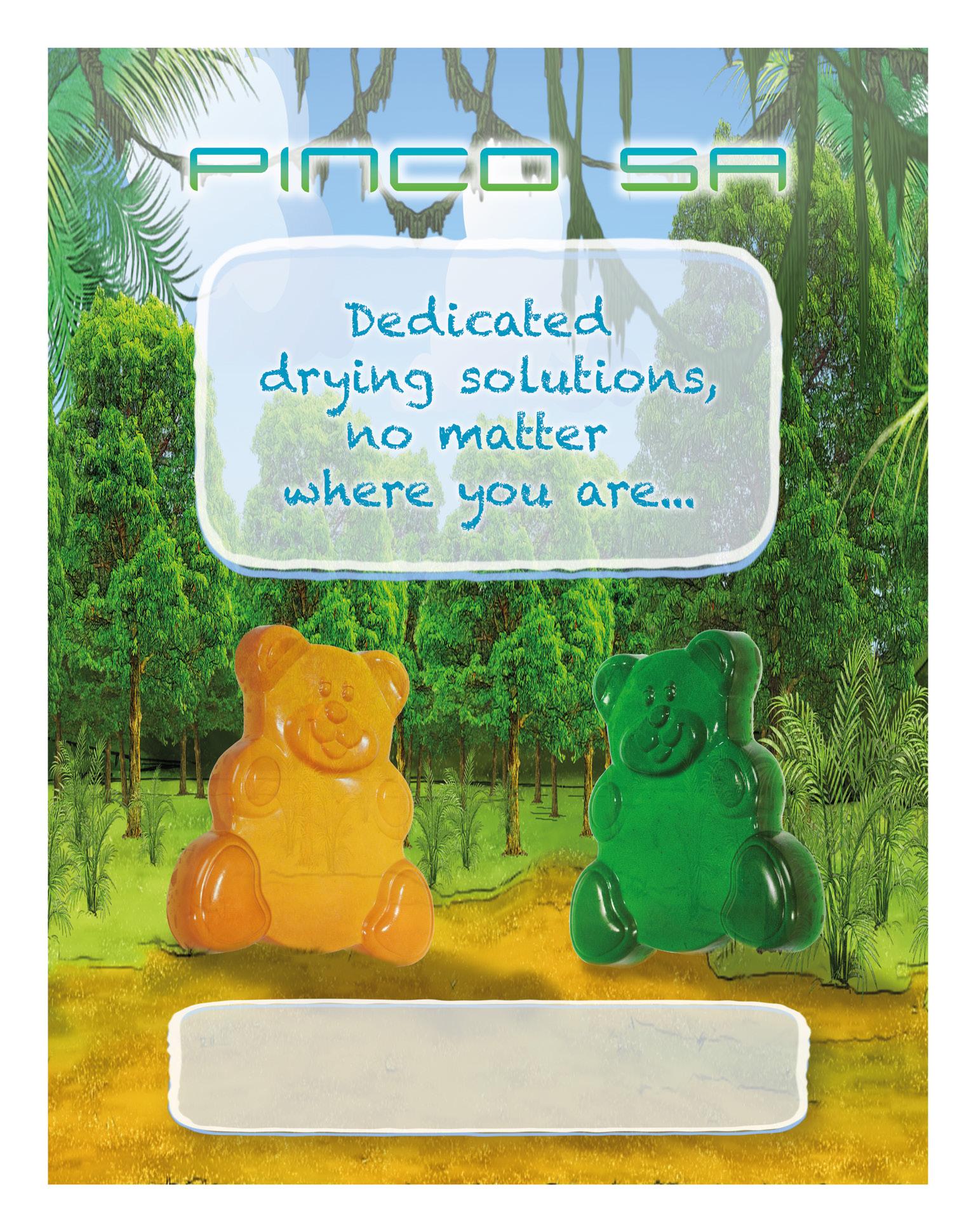
departments
3
PRODUCT TRENDS - Transforming poultry waste into valuable solutions – Facing the plant-based revolution – EU olive oil production update – The world of coffee
14 FOOD PROCESSING - Process technology advancing: three big trends in focus – Dairy processing equipment: global forecast to 2028 – Sarp at Anuga FoodTec – The world of sieving – The future of chocolate and fat creams: Tecno3 and the P10S – How to design plant protein-based sausages – Ohmic heating-based extraction of biocompounds from cocoa bean shell – The influence of hot-air mechanical drying on the sensory quality of coffee – Effect of pulsed electric field treatment on beef cuts properties – New technology to reduce pathogens in intact eggs
30 PACKAGING TRENDS - Packaging and sustainability: alternative materials and flexible machine concepts – Food and packaging experts dare to look to the future
34 PACKAGING EQUIPMENT - Smart intralogistics: innovative solutions for a fully automated supply chain – Innovative solutions for circular packaging (S. Musso) – Innovative packaging solutions from Schubert for high-quality baked goods – P.E. Labellers for Farchioni Olii – Effect of packaging in preventing cholesterol autoxidation in milk chocolates – UVB treatments of packaged ready-to-eat salads
48
NUTRITION - Are all ultra-processed foods linked to cancer and diabetes? – Natural food colors revolutionizing the palate: unleashing the potential of natural ingredients in the evolving food industry – Common food preservatives has unexpected effects on the gut microbiome – Use of cassava flour in the elaboration of ice cream – Ingredient from the fermentation of brewer’s spent grain liquids
56 RESEARCH - Influence of pre-baking and frozen storage on the quality of a multi-seed bread – Upcycling soy processing waste for fat replacement in sweet bread – Replacement of nitrates/nitrites in salami by plant extracts – Extraction technologies to produce food-grade hop extracts – Natural whey starter on cheese whey – Improvement of Robusta coffee aroma by treated spent coffee grounds – Enhancing zein-starch dough and bread properties by addiction of hydrocolloids
62 NEWS - Distillo lands at Simei 2024: together at Milano in November - International events in Italy
64

MARCH 2024 - issue 106
COMPANY INDEX
Four-monthly - ISSN 1590-6515
March 2024
issue 106


Copyright Clearance Center


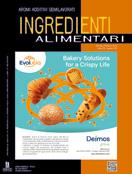
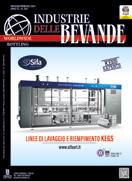
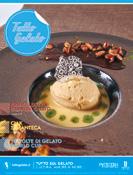
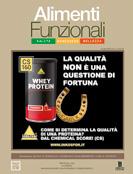
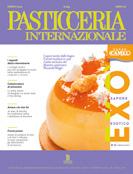

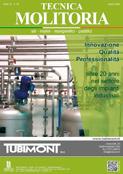
OUR WEBSITES
www.chiriottieditori.it shop.chiriottieditori.it www.foodexecutive.it www.pasticceriainternazionale.it www.tuttogelato.it
www.alimentifunzionali.it

Chiriotti Editori s.r.l. Viale Rimembranza 60 10064 Pinerolo - To - Italia Tel. 0121 393127
info@chiriottieditori.it www.chiriottieditori.it
Publisher
Alberto CHIRIOTTI
Direttore Responsabile alberto@chiriottieditori.it
Contributing Editors
Laura SBARATO, Simonetta MUSSO, Rossella CONTATO, Matteo BARBONI
Assistant Editor
Chiara MANCUSI
mancusi@chiriottieditori.it
Layout Designer
Anna BOSCOLO
Marketing Manager
Monica PAGLIARDI pagliardi@chiriottieditori.it
Advertising Manager
Luca RUSSO russo@chiriottieditori.it
General Manager
Giuseppe CHIRIOTTI
for free subscriptions
call to +39 0121 378147 or send an e-mail to: abbonamenti@chiriottieditori.it
La riproduzione, anche parziale, di articoli ed illustrazioni pubblicati sulla rivista è riservata e non può avvenire senza espressa autorizzazione scritta dell’Editore. L’Editore non assume alcuna responsabilità per quanto riguarda eventuali errori contenuti negli articoli e per quanto espresso dagli Autori.
All Rights reserved. Reproduction, even partial, of articles and illustrations published in the journal is forbidden and can not take place without written permission of the Publisher. The Publisher assumes no responsibility for any errors contained in the articles and for what is expressed by the Authors and/or by the companies.
PRINTED by La Stamperia Pinerolese srls Pinerolo (To)
COPYRIGHT:
© 2024 Chiriotti Editori srl Supplemento del mensile “Industrie Alimentari”
AUTORIZZAZIONE: n. 262 (19-11-1962) del Tribunale di Pinerolo
PERIODICITÀ:
mensile - sped. in A.P. comma 20/B, art. 2, legge 662/96Torino
INTERNET: www.chiriottieditori.it
PRODUCT TRENDS
Transforming poultry waste into valuable solutions
Rendered poultry products are derived from the rendering process applied to poultry, which includes chickens and turkeys. Rendering is a technique where the raw poultry material is heated to separate & extract the fat & and protein components. Poultry fat is a frequently consumed rendered poultry product obtained by melting the fatty tissues of poultry. Depending on its intended application, poultry fat can undergo further processing to take on different forms, such as liquid or solid fat. It is widely utilized in the food industry for purposes such as cooking, frying, and as an ingredient in various processed food products. The addition of poultry fat in food preparations can enrich the flavor, improve moisture retention, and contribute to the desired texture of the final food items.
Trends in rendered poultry products industry
Increase in global demand for animal-based protein is fueling the market for processed poultry products. With the continuous growth of the global population, there is a greater need for protein sources to fulfill nutritional needs. Chicken and turkey, which are considered valuable protein sources, are in high demand due to their excellent amino acid profile and
nutritional advantages. To address this demand, rendered poultry products such as poultry meal are crucial as they offer a concentrated & cost-effective protein source for animal feed formulas. The expanding livestock, aquaculture, and pet food industries are significant contributors to rise in demand for rendered poultry products.
According a marketing report released by Allied Market Research company, the rendered poultry products market is experiencing substantial growth due to increase in emphasis on waste reduction and resource optimization. Through the rendering process, valuable components from poultry byproducts that would typically be discarded can be extracted and utilized effectively. This process transforms these byproducts into useful products such as poultry fat and poultry meal, minimizing waste and maximizing the value of poultry resources. This approach aligns with the principles of sustainability and the circular economy, which are becoming increasingly important in various industries. The market is benefiting from rise in recognition of rendering as a sustainable solution that reduces environmental impact and promotes efficient resource utilization.
Over the past 50 years, the poultry industry has undergone significant transformations both in the U.S. and globally. While the consumption of poultry
italian food & packaging technology - cvi (2024) - march 3
and its products has experienced a substantial increase, the industry’s structural changes have been even more remarkable. From being a small-scale producer catering to specialty meals, the poultry industry has emerged as a major source of animal protein consumption. This growth is mirrored across the globe, where poultry production has seen a significant expansion. In 2021, chicken production and slaughter in the U.S. reached 9 billion. Furthermore, global chicken slaughter has reached an all-time high, surpassing 70 billion annually.
The demand for rendered poultry products is being propelled by the expanding food processing industry. Poultry fat, in particular, is a versatile ingredient that finds various applications in the food processing sector. It is utilized for cooking, frying, and as an ingredient in processed foods to enhance flavor, improve texture, and provide moisture. With the continuous growth of the food processing industry, there is an increase in the need for dependable and high-quality sources of poultry fat. Rendered poultry fat meets these requirements and provides cost-effective solutions to food manufacturers. Moreover, the convenience and versatility of rendered poultry products make them valuable components in a wide array of processed food products, further driving the growth of the market.
Application of Rendered Poultry Products
Rendered poultry products find diverse applications in different industries. Here are some of the ways these products are used:
• Animal Feed: Rendered poultry products are commonly included in animal feeds such as pet foods, livestock feeds, and aquafeeds. With their high protein content, they serve as valuable ingredients for animal nutrition. These products enhance feed formulations by supplementing protein levels and providing essential amino acids.
• Fertilizer and Soil Amendment: Certain rendered poultry products, such as bone meat and feather meal, are utilized as organic fertilizers and soil amendments. They contain essential nutrients such as nitrogen, phosphorus, and calcium, which contribute to plant growth. These products are commonly used in agriculture and horticulture to enhance soil fertility and foster healthy plant development.
• Biofuel Production: Rendered poultry fat can be transformed into biodiesel, a renewable fuel source. Through a process called transesterification, the fat is converted into biodiesel, which can serve as an alternative to conventional diesel fuel. Rendering plants often supply their poultry fat to biodiesel producers as a feedstock for biofuel production.
• Industrial Applications: Rendered poultry fat finds application in various industrial sectors. It can be utilized in the manufacturing of soaps, detergents, candles, and cosmetics. The fat possesses emollient properties and acts as a natural moisturizer in personal care products.
• Pharmaceutical and Nutraceutical Uses: Certain components derived from rendered poultry products, such as collagen, have applications in the pharmaceutical and nutraceutical industries.
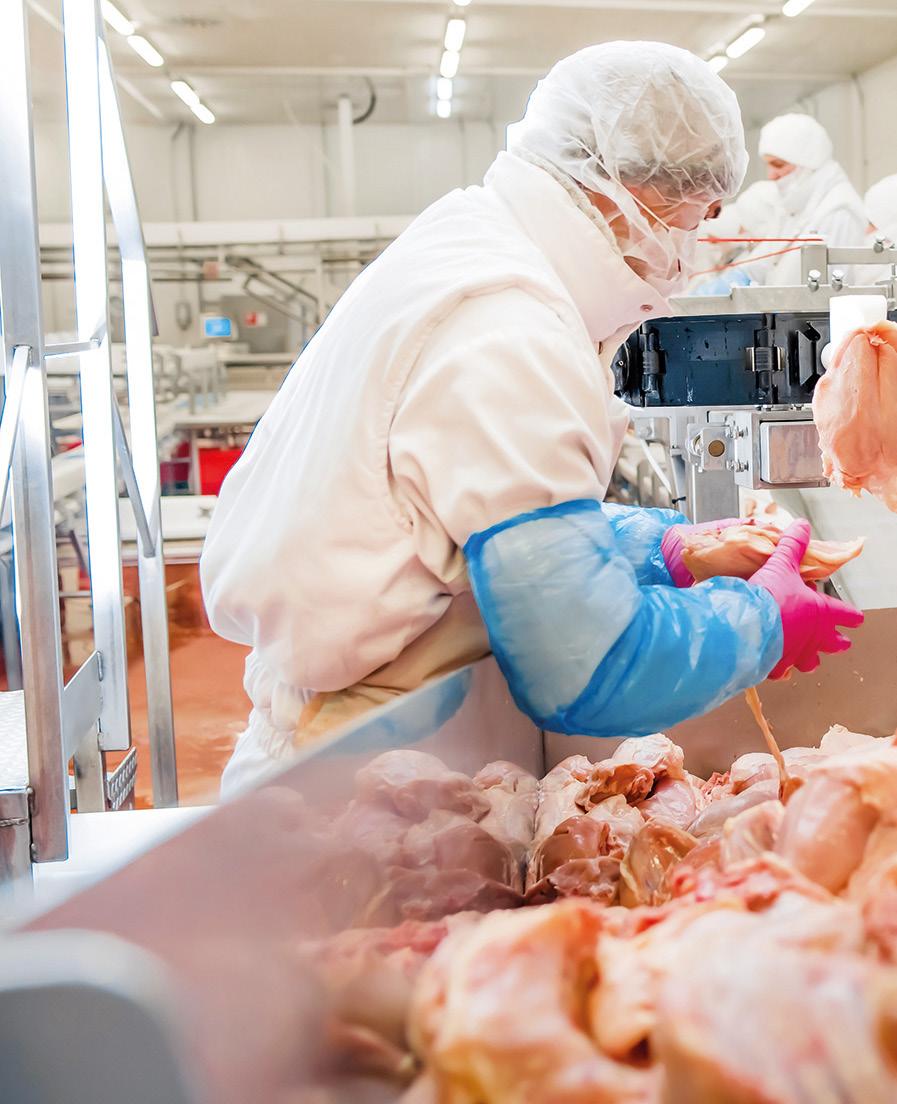
product trends 4 italian food & packaging technology - cvi (2024) - march
Collagen, a protein present in the connective tissues of animals, including poultry, is used in the production of capsules, tablets, and topical formulations. Its potential benefits for skin health, joint health, and wound healing make it a valuable ingredient in these products.
Opportunities for Expansion into Emerging Markets
Expanding into emerging markets presents a significant growth potential for the rendered poultry products industry. As economies in regions such as Asia, Latin America, and Africa continue to develop and disposable incomes rise, there is growth in demand for protein-rich foods, including poultry products. These new markets
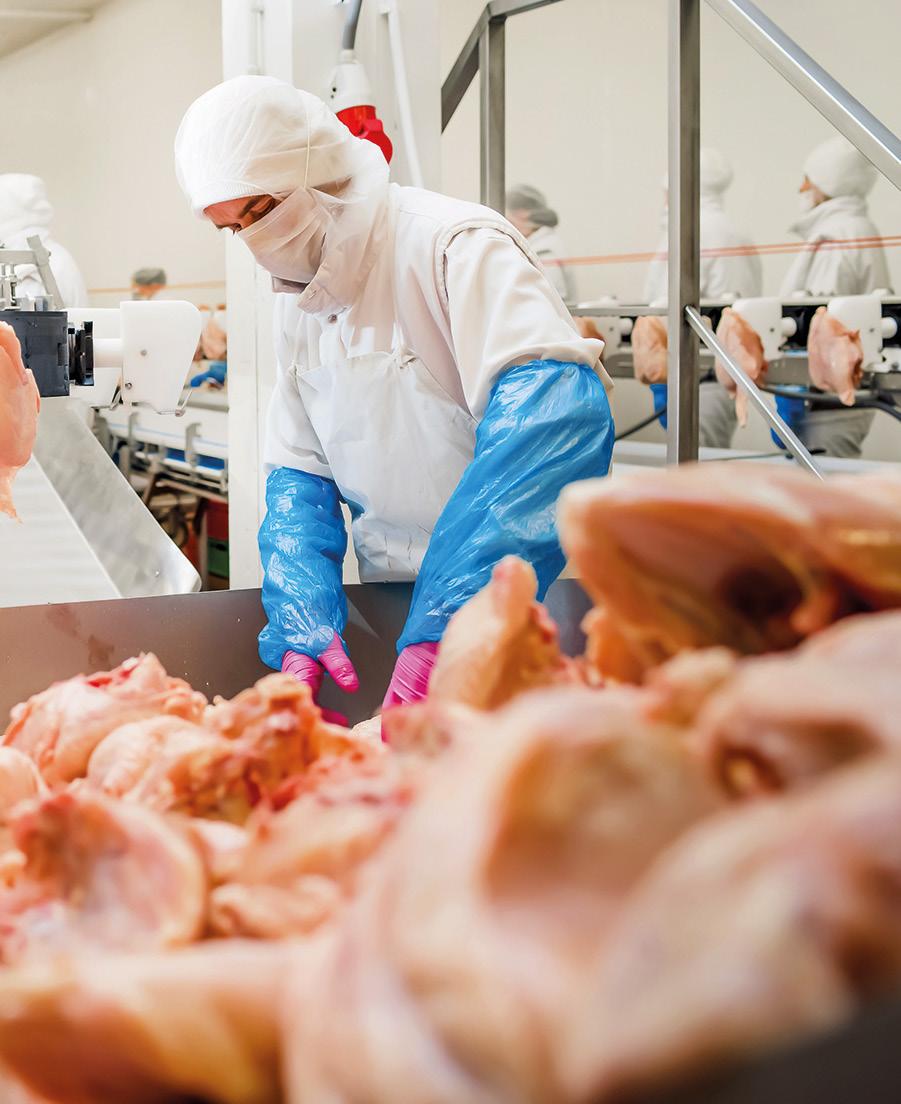
offer plenty of chances for selling poultry products that have been processed, especially in the form of poultry meal, which is an important ingredient in animal food recipes. By venturing into these emerging markets, companies can take advantage of increase in demand and establish a robust presence, which will drive the growth of the market.
Technological Advancements and Process Innovations
The rendered poultry products market is witnessing growth opportunities through technological advancements and process innovations. Ongoing R&D endeavors are dedicated to enhancing rendering processes, improving product quality, and increasing the overall efficiency of animal feed. Innovative technologies, including advanced rendering techniques and equipment, have the potential to streamline the rendering process, leading to higher yields and improved product consistency. Moreover, advancements in extraction & and purification methods can contribute to producing rendered poultry products with enhanced nutritional profiles and reduced impurities.
Rise in Demand for Specialty & Value-added Products
The rendered poultry products market holds significant growth opportunities due to an increase in consumer demand for specialty & and value-added products. Presently, consumers prefer products with specific attributes, such as organic, natural, or sustainably sourced ingredients. To cater to these preferences, rendered poultry products can be positioned to offer specialty and value-added variations. For instance, producing organic or freerange poultry fat or poultry meal can tap into the niche market of consumers seeking premium and ethically produced ingredients. In addition, the development of value-added products, such as flavored or functional poultry fat, can align with consumers’ evolving tastes and healthconscious preferences. By leveraging these trends and offering differentiated products, companies can target new market segments and drive growth in the industry.
product trends italian food & packaging technology - cvi (2024) - march 5
Facing the plant-based revolution
The food industry has now been leaning heavily toward plant-based products. People are looking for healthier choices, making plant-based foods a thriving market. Sustainable choices like meat alternatives and plant-based drinks have become a preferred choice among individuals. This, in turn, is creating great opportunities for businesses to succeed in this domain.
Here are some recent trends in the industry
Dominance of plant-based protein: The demand for plant-based protein sources is on the rise. Beyond traditional sources like tofu and legumes, innovative products like pea protein, hemp protein, and algae-based proteins are gaining much popularity.
Alternative meat revolution: Plant-based meat alternatives are now becoming a favored choice since they imitate the taste and texture of traditional meat products. Companies like Beyond Meat and Impossible Foods have come up with burgers, sausages, and even different chicken substitutes that taste no less than real meat.
Dairy-free craze: On the other hand, plant-based milk alternatives such as almond, soy, oat, and coconut milk have come to the fore. The dairy-free trend extends beyond milk to include plant-based cheeses, yogurts, and ice creams. When it provides delicious alternatives for those with lactose intolerance, it also helps people seeking a vegan lifestyle.
Snacks: Plant-based snacks are also being popular. From chickpea puffs to vegan sandwiches con-
sumers are looking for convenient and tasty plantbased options to cater to their cravings for snacks.
Functional foods: Consumers nowadays look for taste along with nutritional value. There’s a growing interest in plant-based foods with added health benefits. Thus, products added with superfoods and other functional ingredients are becoming popular.
Plant-based seafood: Companies are coming up with plant-based alternatives to conventional sea-
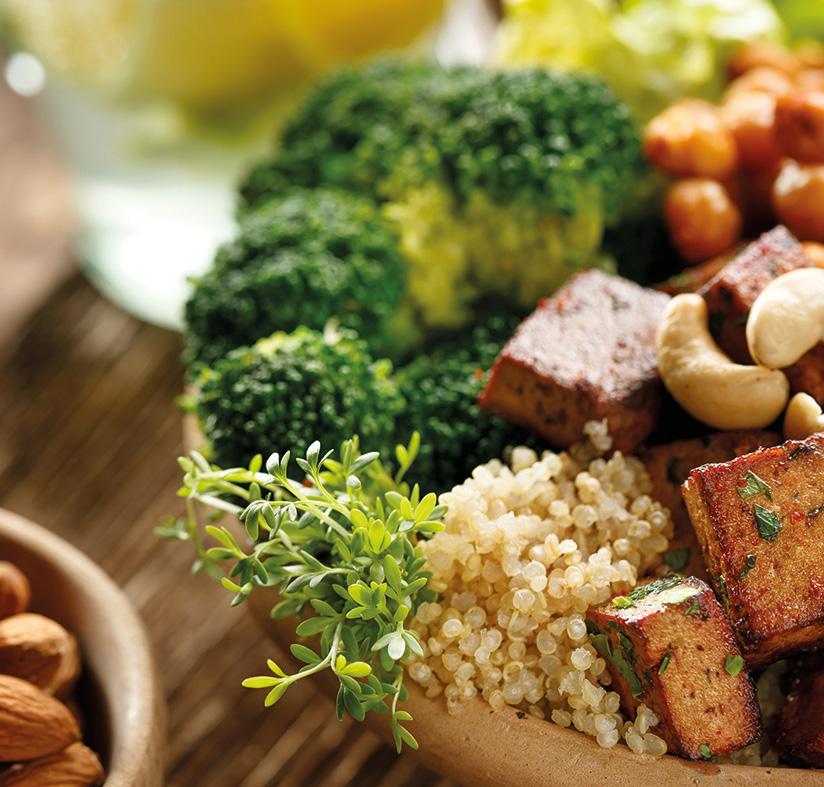
product trends 6 italian food & packaging technology - cvi (2024) - march
food products. This, in turn, offers a cruelty-free and eco-friendly option. As sustainability concerns rise, plant-based seafood options are becoming an instant hit.
Tech innovations: Last but not the least; new technologies in the food industry are boosting the plant-based scenario, especially with the invention of 3D-printed veggie steaks and lab-grown meat. These innovations offer eco-friendly options for foodies.
Plant-based beverage market
One of the key segments leading this charge is the plant-based beverage market. Companies like Oatly and Califia Farms are trying to make the most of the growing consumer preference for dairy alternatives. With an array of options ranging from almond milk to oat milk, these companies are not only meeting the demand for plant-based alternatives but also setting new standards for taste. These healthy choices are meeting the nutritional value too.
Plant-based meat market: Beyond beverages, the plant-based meat market has witnessed significant growth, challenging traditional notions of protein sources. Key players such as Beyond Meat

and Impossible Foods have redefined the concept of meat. They offer plant-based alternatives that are almost similar to the taste and texture of animal-based products. Increasing awareness of environmental sustainability and animal welfare concerns among consumers has driven this shift.
Plant-based seafood market: To cater to the craze for sustainable choices, the plant-based seafood market is also making noteworthy moves. Companies like Good Catch and New Wave Foods are leading the way in making seafood-like dishes from plant-based stuff. When they are providing people with what they want, they’re also helping keep our oceans safe.
Plant-based diet and protein supplements: Eating plant-based isn’t just about specific foods. It’s a whole approach to healthy eating. Companies like Vega and Garden of Life are trying to meet the demand for plant-based options. They provide various products, from protein supplements to meal replacements. This way, they are making it simple for consumers to adopt a plant-focused lifestyle and establish a sustainable market.
Plant-based food ingredients: Simultaneously, the plant-based food ingredients market plays a crucial role in shaping the products consumers see on their shelves. For example, Ingredion and Cargill are providing special ingredients that help improve the flavor, texture, and nutrition of these foods. As more people want plant-based options, these companies are playing an important role in helping food makers create plant-based products that are really good.
Plant-based baby care products: Even babies are getting in on the plant-based trend! Brands like Happy Family Organics and Earth’s Best are making plant-based baby care products such as organic baby food and eco-friendly diapers. They’re catering to parents who want sustainable and cruelty-free options for their little ones.
To sum up, it can be stated that the global plantbased foods market is undergoing a significant transformation driven by high-end innovations. Success in this realm relies on businesses being adaptable and ensuring high quality. Those embracing plant-based foods are not just keeping up with today’s needs but are also influencing the future of the entire food industry.
product trends italian food & packaging technology - cvi (2024) - march 7
www.alliedmarketresearch.com
EU olive oil production update
According to the USDA analysis, in 2023/24 the EU is facing a second consecutive short olive oil production crop. Consumer price increases resulting from the limited domestic availability will contribute to reduced consumption, while the short crop will also preempt exports from expanding for the second consecutive year, while also continuing to push stock levels down.
Production
Estimates based on precipitation levels to date, temperatures during the olive trees flowering season, and the subsequent extreme summer heat waves that resulted in unripe fruit dropping, indicate that the European Union’s olive oil output in MY 2023/24 could amount to just above 1.4 million metric tons.
Olive harvest in the EU runs from fall to the beginning of spring. While spring conditions determine flowering and summer temperatures influence fruit development, fall precipitations still play a role in final output levels. Olive tree’s alternative bearing also plays a role in production volumes. New plantations under irrigation entering production also continue to soften the impact of alternative bearing in olive oil production levels across the EU. The EU’s olive oil production is concentrated in a handful of Member States.
The EU is the world’s largest olive oil producer, accounting for over 60% of the world production.
In Spain, which produces about half of the world’s olive crop, extreme weather conditions resulted in short production for a second year. After a spring heat wave impacted flowering, the harvest in Spain was forecast to be only 15% larger than last year, which was the worst olive oil production year in nearly a decade. A series of summer heat waves caused trees to drop unripe fruit to conserve moisture.
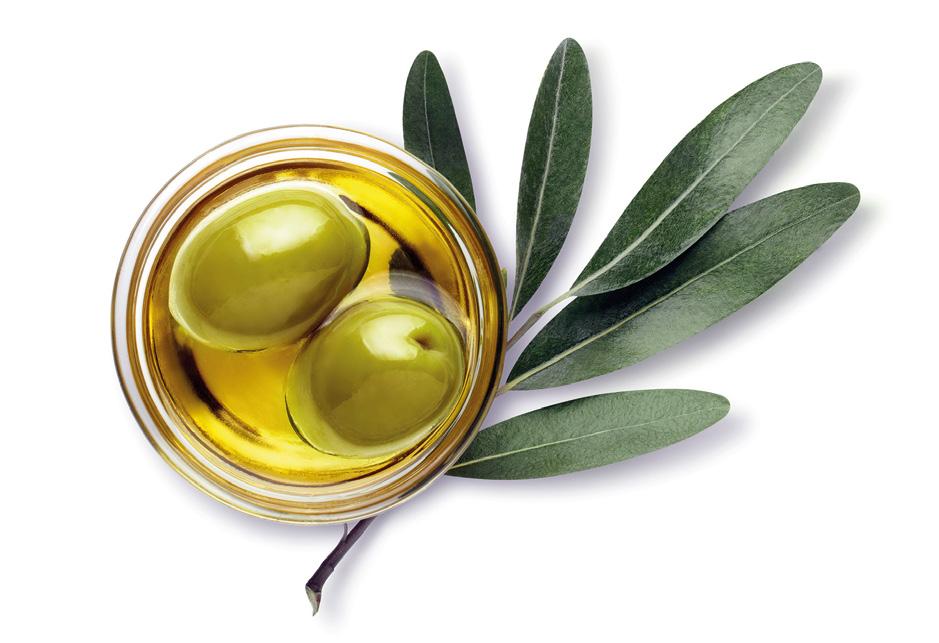
product trends 8 italian food & packaging technology - cvi (2024) - march


However, abundant fall precipitation contributed to improve the initially negative production outlook. The latest official estimates indicate that olive oil production in Spain in MY 2023/24 may reach up to 765,200 tons.
In Italy, MY 2023/24 olive oil production is forecasted at 300,000 tons, mainly due to the promising conditions in the regions of Puglia, Calabria and Sicily, which account for approximately 70% of the country’s olive oil production.
Greece’s MY 2023/24 olive oil production could be as low as 180,000 tons. The mild winter did not favor flowering and extensive rainfall in spring further reduced fruit-set. Additionally, extremely hot summer conditions followed by autumn rainstorms ‘Daniel’ and ‘Elias’ reduced the yields in the central Greece area. Chalkidiki in the north and Crete in south Greece also report significant olive oil production decreases.
Consumption
MY 2023/24 and MY 2022/23 olive oil consumption has been revised down compared to previous estimates in response to soaring EU olive oil consumers’ prices in the main producing and consuming countries. Likewise, olive oil prices in producers’ markets in the EU also far exceed previous season’s levels.
Trade
The second consecutive short EU olive oil crop is expected to limit the bloc’s export potential in MY 2023/24. The EU’s total olive oil export levels in MY 2022/23 also declined significantly, driven by the limited domestic availability. The United States followed by Brazil are the main destinations for EU olive oil exports.
In MY 2023/24, EU olive oil imports are anticipated to recover marginally, provided a production rebound in Tunisia materializes. According to the latest trade data available, in MY 2022/23, the larger olive oil imports originated in Turkey, which saw their production increase in MY 2022/23, nearly countering the reduced imports from the EU’s traditional suppliers such as Tunisia or Morocco, where olive oil availability was lower in MY 2022/23.
Stocks
Despite the somewhat reduced internal consumption and exports, olive oil stocks in the EU are expected to be tight by the end of MY 2023/24 given the two consecutive short crops that have reduced availability of olive oil within the EU.
www.usda.gov
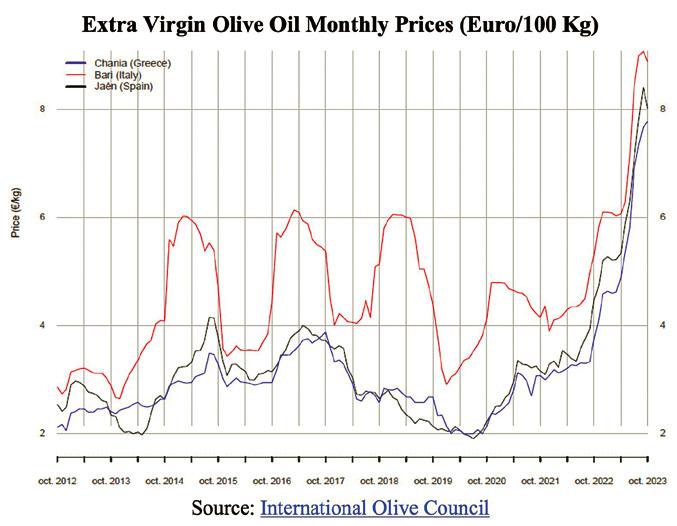
product trends italian food & packaging technology - cvi (2024) - march 9
The world of coffee
The United States Department of Agriculture (USDA) published a report on the global coffee market
European Union: World’s Top Coffee Importer
European Union (EU) imports are dominated by unroasted green coffee beans, which accounts for about 90% of trade. Top suppliers in 2022/23 (October through September) included Brazil (32%), Vietnam (26%), Uganda (7%), and Honduras (6%). Imports reached a record 49.1 million bags the previous year but slipped 2.6 million bags this year as lower imports from Brazil more than offset gains from Vietnam. These two countries accounted for 54 to 58% of EU green coffee imports over the last 10 years, leaving limited market share for other suppliers. During this same period, Uganda gained 1.2 million bags to total 3.4 million on rising production while Colombia lost 500,000 bags to total 1.8 million on falling output.
EU imports of roasted coffee totaled just 1.4 million bags in 2022/23, down from a record 2.1 million bags 4 years earlier on reduced imports from Switzerland. Top suppliers included Switzerland (77%) and the United Kingdom (13%). Because coffee beans begin to lose flavor and aroma shortly after being roasted, these imports are mostly limited to neighboring non-producing countries.
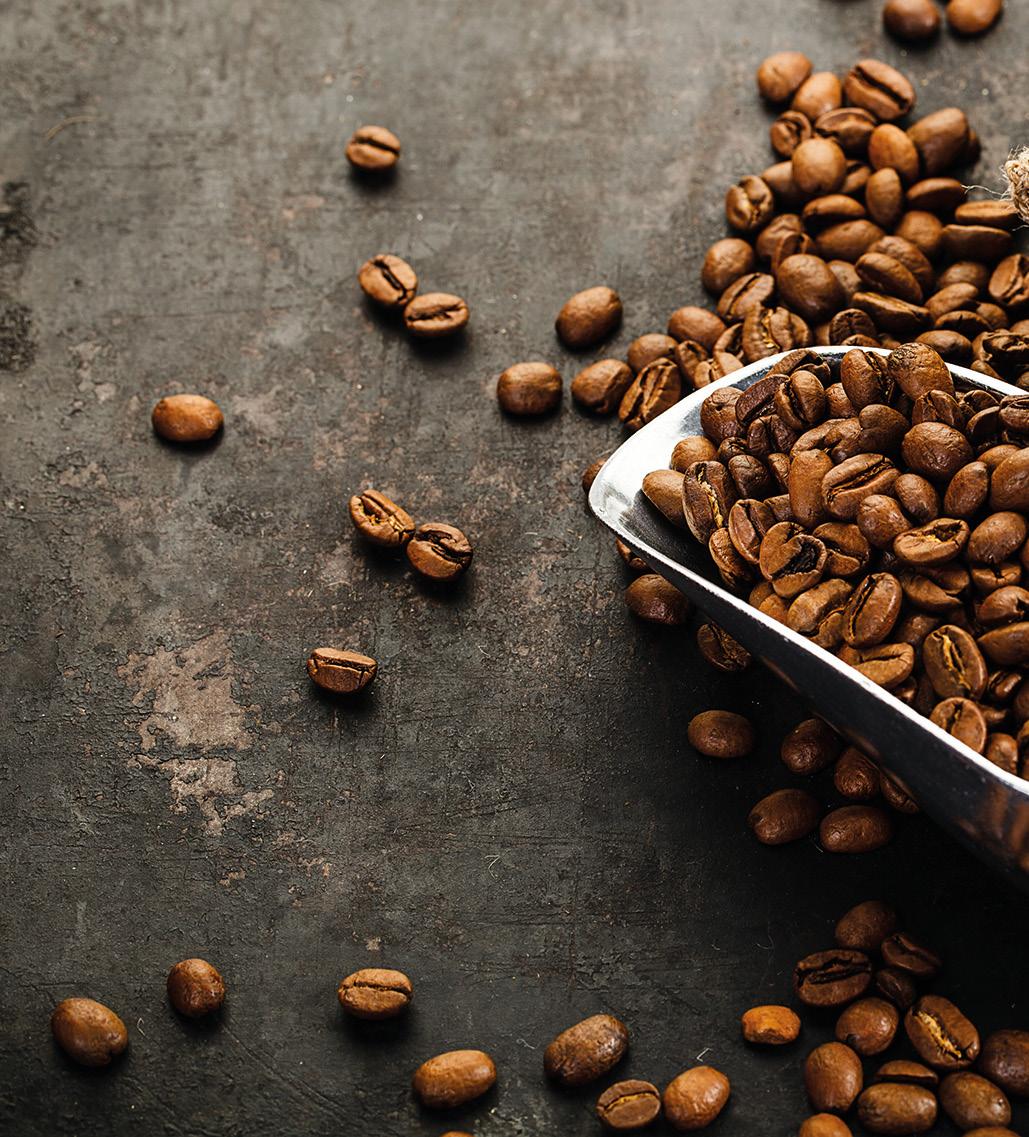
product trends 10 italian food & packaging technology - cvi (2024) - march

Imports of soluble coffee rebounded 300,000 bags to 3.7 million in 2022/23. Top suppliers included the United Kingdom (34%), Vietnam (12%), India (12%), and Ecuador (10%). While imports from the United Kingdom have been nearly flat at 1.3 million bags for a decade, imports from India and Vietnam gained about 300,000 bags to each total over 400,000.
EU green coffee imports are forecast to rebound slightly in 2023/24 to 47.0 million bags primarily due to stronger shipments from Brazil, while roasted and soluble coffee imports remain flat at 1.4 million bags and 3.7 million bags, respectively.
2023/24 Coffee Overview
World coffee production for 2023/24 is forecast to reach 171.4 million bags (60 kilograms), 6.9 million bags higher than the previous year. Higher output in Brazil, Colombia, and Ethiopia is expected to more than offset reduced production in Indonesia. Global coffee bean exports are expected up 8.4 million bags to 119.9 million, primarily on strong shipments from Brazil. With global consumption forecast at a record 169.5 million bags, ending inventories are expected to continue to tighten to a 12-year low of 26.5 million bags.
Brazil combined Arabica and Robusta harvest is forecast up 3.7 million bags to 66.3 million in 2023/24. Arabica output is forecast to improve 5.1 million bags to 44.9 million. In January 2023, coffee trees in top growing region Minas Gerais experienced
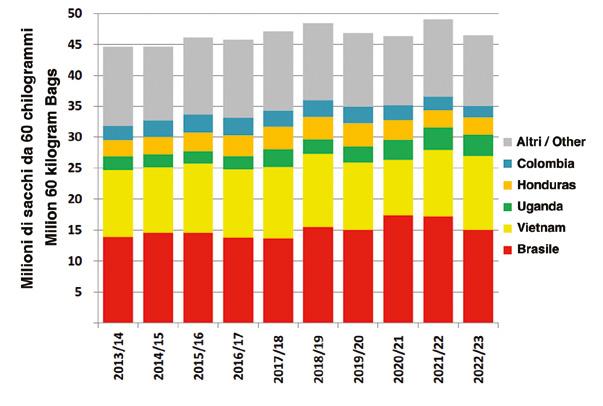
product trends italian food & packaging technology - cvi (2024) - march 11
Brazil and Vietnam Drive EU Green Coffee Imports.
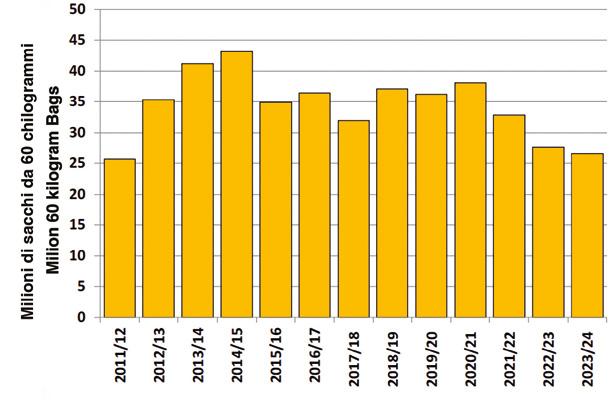
higher than average rains during the fruit development stage, causing difficulties for some growers in controlling plant diseases and pests. However, increased precipitation resulted in coarser and heavier beans compared to the last crop, which contributed to production gains. Although output is expected to expand, this quantity is below previous crops that peaked at nearly 50.0 million bags. Arabica trees in many growing regions continue to recover from severe weather that occurred in 2021 including severe frosts, high temperatures, and below average rainfall that lowered production in 2021/22 and 2022/23. Following 6 years of expansion, the Robusta harvest is forecast to decline 1.4 million bags to 21.4 million as reduced precipitation and cooler temperatures leading up to the flowering stage lowered yields in Espirito Santo, where the vast majority is grown. Coffee bean exports are forecast to rebound 7.3 million bags to 39.5 million, fueled by higher supplies and stronger EU and U.S. import demand.
Vietnam production is forecast to add 300,000 bags to reach 27.5 million. Cultivated area is forecast unchanged, with nearly 95 percent of total output remaining as Robusta. However, with lower total supplies due to last year’s stocks drawdown, bean exports are forecast to decline 2.4 million bags to 23.0 million.
Colombia Arabica production is forecast up 800,000 bags to 11.5 million on slightly higher yields. However, yields remain nearly 15 percent below normal because growers limited fertilizer use due to high prices. Bean exports, mostly to the United States and EU, are forecast up 1.2 million bags to 10.8 million on strong demand.
Indonesia combined Arabica and Robusta harvest is forecast down 2.2 million bags to 9.7 million. Robusta production is expected to drop 2.1 million bags to 8.4 million. Excessive rain during cherry development lowered yields and caused sub-optimal conditions for pollination in the lowland areas of Southern Sumatra and Java, where approximately 75% of coffee is grown. Arabica production is seen dipping slightly to 1.3 million bags. Bean exports are forecast to plummet 2.7 million bags to 5.0 million on sharply reduced supplies.
India combined Arabica and Robusta harvest is forecast nearly unchanged at 6.0 million bags. Arabica production is forecast to drop 200,000 bags to 1.4 million due primarily to a prolonged dry spell from December 2022 to March 2023 which was followed by poor pre-monsoon rains. Robusta production is expected to rise 300,000 bags to 4.5 million on slightly higher yields. Bean exports are forecast up 300,000 bags to 4.3 million on a slight inventory drawdown.
www.usda.gov

product trends 12 italian food & packaging technology - cvi (2024) - march
World Ending Stocks Continue to Tighten.
Brazil Arabica Production Continues Rebound as Robusta Slips.





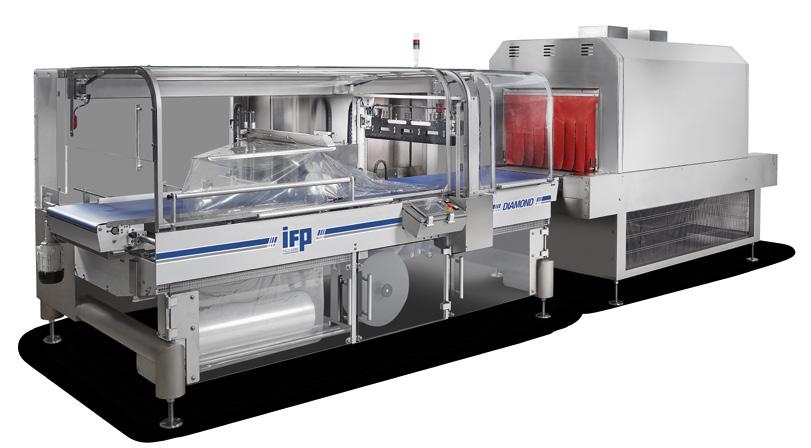
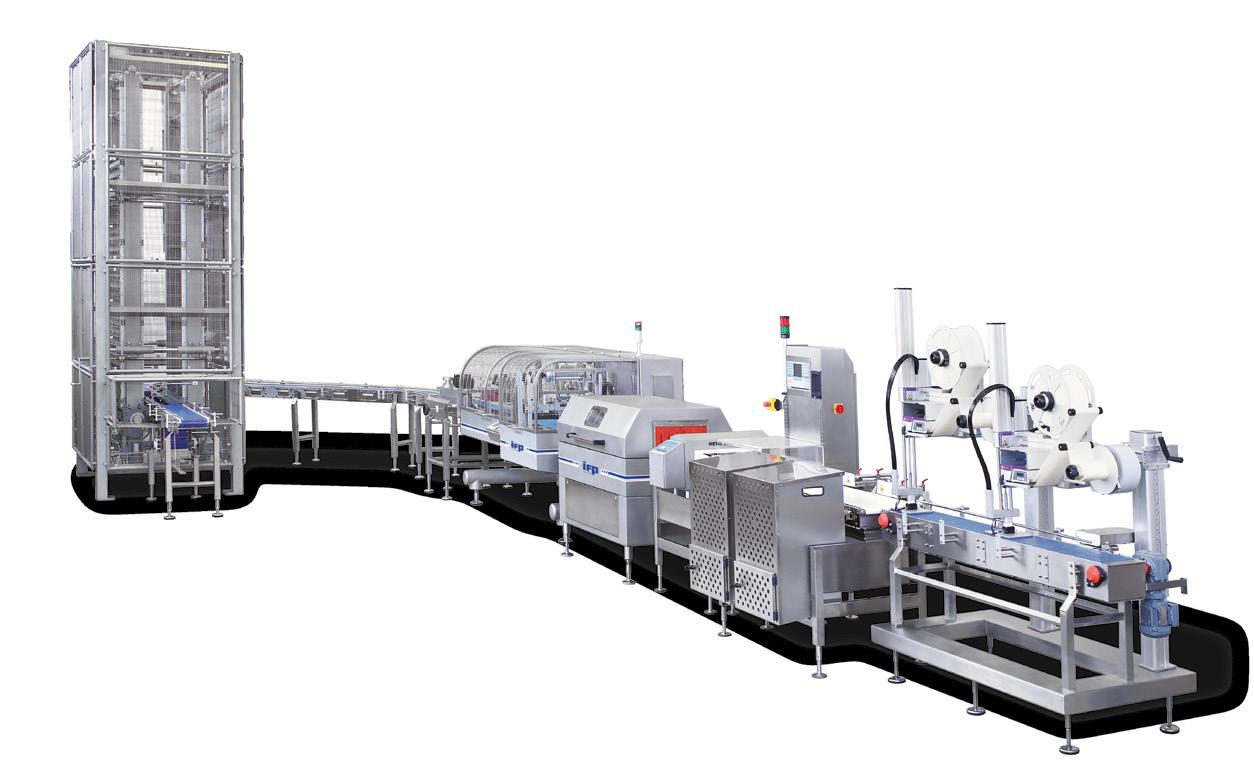



product trends
FOOD PROCESSING
Process technology advancing: three big trends in focus
Whether it is about complete production lines or individual process systems for milk products, cheese, beverages and viscous food – Best Practice technologies are currently called for that ensure both efficiency and product quality. At the same time, these systems must be scalable and flexible, in order to also be able to process new ingredients in future. In advance of Anuga FoodTec, which is taking place from 19 to 22 March 2024 in Cologne, it is becoming clear that the latest generation of process technology systems distinguishes itself through three important trends: digitalisation, sustainability and individualisation.
The goal of sustainably redesigning the food and beverage industries has never been as urgent as it is today. All the more important is it for producers to efficiently and flexibly use systems that are appropriate for this task.
Not least, the consistently high quality of food and food safety is in the focus of developments. “Globally, we are seeing innovations of completely different kinds in process technology. This diversity is also reflected on the Cologne fair grounds at the stands of the exhibitors”, says Matthias Schlüter, Director of Anuga FoodTec . More than a third of the around 1,350 exhibitors from Germany and abroad present solutions in the field of process technology. And these already start with mixing – a complex process that
often takes place at the start of production.
Efficient in every production step
Mixers are the workhorses of the food industry and are indispensable for the standardisation of product masses. Where a simple batch mixer was sufficient 15 years ago to process standard recipes with few ingredients, the situation has fundamentally transformed. The market is now more dynamic than ever before. Manufacturers change recipes several times per day in order to adapt their production to the changing wishes of consumers. A modern mixer must be able to master this complexity and be capable of mixing varied raw materials equally wet and dry, and that without mak-
14 italian food & packaging technology - cvi (2024) - march
ing the process more difficult. At Anuga FoodTec, visitors will find a great variety of models that can be adapted to the respective requirements. An example of this are trajectory mixers. They introduce the shear forces by way of the inertia of the mass through the use of programmable trajectories. The highlight: the product found in the process container processes itself gently with itself, entirely without stirring tools.
However, there is more than one process step behind the manufacture of food. The stirrers, kneaders, mixers, extruders, homogenisers and heat exchangers on the Cologne fair grounds are flanked by a large number of digital solutions that are specifically coordinated to the processes and network these to form a complete line. Recipe and batch management software makes it possible to plan and control fully-automated production. Thanks to central terminals, all functions, such as rotational speeds, vacuum values, exposure to gas or the speed of the conveyor systems, can be monitored and operated by one person. User-friendly designs ensure process-safe and intuitive operation and are also a response to the lack of skilled workers in the industry.
Digital and networked along the entire line
The optimisation of production processes occupies a lot of space at Anuga FoodTec. It is primarily the digital technologies that provide insights into the processes that were not so available in the past. Food manufacturers use this as the
foundation for elevating their own production to the latest standard and to optimise the harmonisation of human being, machine and processes. With their portfolio, the exhibitors in Cologne begin at precisely this point – for example, with intelligent sensor and web-based process control systems that can also be retrofitted on exist-
sorting then subsequently ensure that the products are finally packaged and ready for shipping. With such an integrated complete solution, the individual product components for ready-made meals pass without interruption through the weighing and filling stations and are subsequently filled cleanly into bowls and sealed.

ing systems. They enable comprehensive sustainability management at the central point of the plant control system.
This enables cross-process automation from the preparation of raw materials with mixing and reduction through processing with portioning, dispensing, molding or extrusion to options like gripping and insertion of the products into the packaging. Intelligent feeds and precise
Gentle processing for higher quality
Food manufacturers face not only the challenge of continually improving the efficiency of their processes. They must at the same time ensure the durability and the quality of their products. Against this background, non-thermal preservation processes remain the trend. The solutions to be found in Cologne
food processing italian food & packaging technology - cvi (2024) - march 15
are bundled under the term “Minimal Processing”. These include, for example, high pressure processing (HPP). This enables the gentle preservation of food at 6,000 bar, without heat or additives. The products are treated
ily used to date with vegetables and fruit. When producing French fries, PEF pretreatment has become the standard in the meantime. It results in a better cut appearance, reduced loss of raw material and starch losses
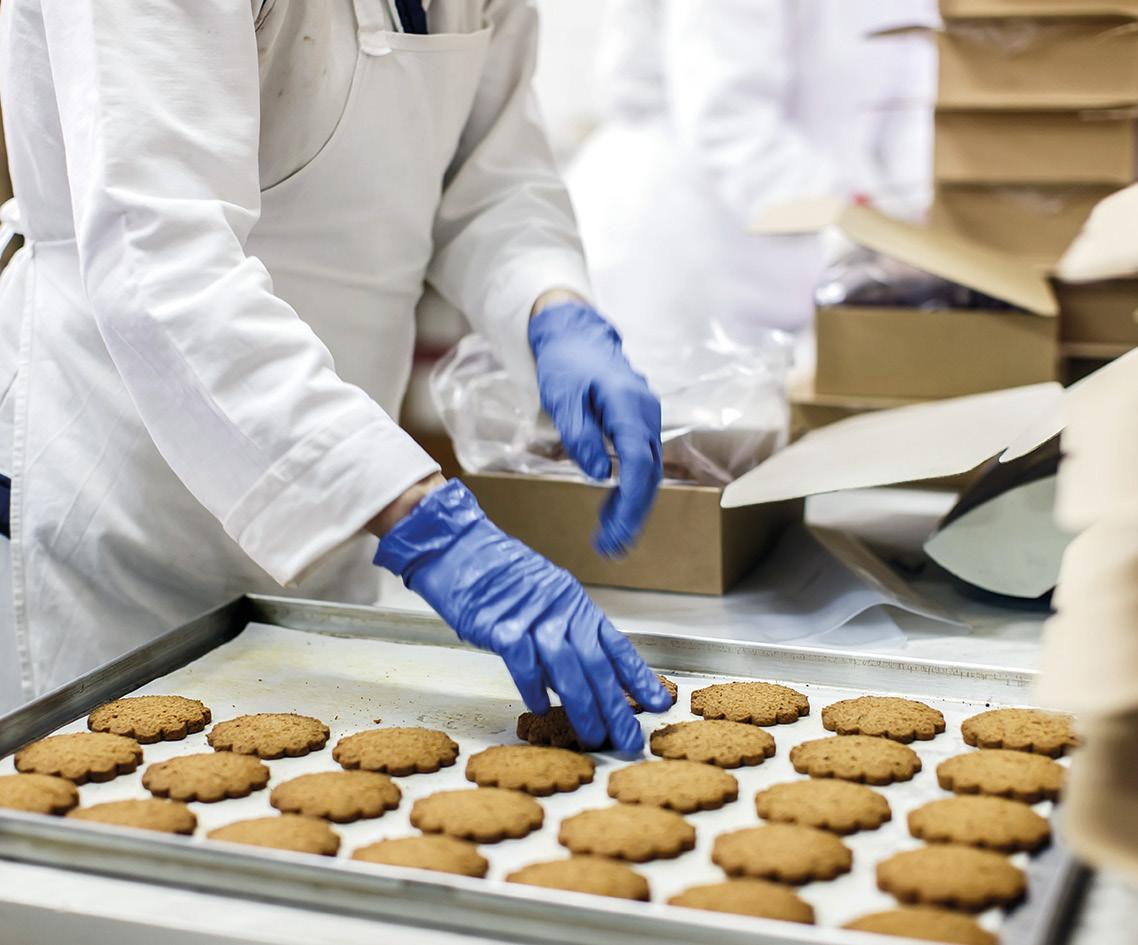
directly in the final packaging. Because high temperatures are unnecessary, the products remain fresh and of a high quality. That works as well for vacuum and modified atmosphere packaging (MAP) as it does with PET bottles.
New application areas in food processing are also always arising for pulsed electric fields (PEF). The technology is primar-
for manufacturers. The process can be combined with conventional drying methods like hot air, freeze, vacuum, microwave or infrared drying and increases the attractiveness of the dried products – with reduced consumption of water and energy. The technology has recently promised great potential for the manufacture of wine or native olive oil. The principle of electro-
poration and the resulting discharge of cell sap is applied here to extract valuable ingredients.
The future of food production
From 19 to 22 March 2024, Anuga FoodTec will show what levers food producers can apply to elevate their production processes to the next level of resource efficiency and product quality. The exhibition programme will be complemented by conferences with prominent guests, interactive forums, panel discussions and lectures, special events, guided tours as well as the presentation of the International FoodTec Award 2024. The Main Stage Responsibility (Hall 9, B080/ C081) and the Innovation Stage (Hall 5.2, C100/D119) revolve around themes like automation, digitalisation, robotics, sustainability and process optimisation. “This overarching perspective of Anuga FoodTec on developments of the industry thereby helps with reaching investment decisions for new technologies”, according to Matthias Schlüter. The Best Practice technologies shown at the trade fair offer trade visitors valuable stimuli in this regard.
Anuga FoodTec is the leading international supplier fair for the food and beverage industries. Organised by Koelnmesse, the trade fair takes place from 19 to 22 March 2024 in Cologne and places the emphasis on the key theme of Responsibility. The professional and industry sponsor is the DLG, the German Agricultural Society.
www.anugafoodtec.com
food processing 16 italian food & packaging technology - cvi (2024) - march
“RAPID” PUMPS
Sanitary - Self priming. Both for liquid and for thick products (Creams and Sauces).
“FARMINOX” FILTERS
Packingless plate filters. Working through paperboard filter-sheets.

HYGIENIC DESIGN
for an easy cleaning.
SAFETY
FDA certified materials, suitable for the use in contact with foods.
ENDURANCE
made of stainless steel machined from bars, NO CAST PARTS, NO WELDINGS.
info@wolhfarth.it - www.wolhfarth.it V. Cavour, 31 - 26858 Sordio (LO) - Italy - Tel. +39 02 9810153 - Fax +39 02 98260169
THE MOMENT FOR A NEW BEGINNING!
Dairy processing equipment: global forecast to 2028
According to MarketsandMarkets agency, the global dairy processing equipment market is projected to reach USD 14.4 billion by 2028 from 10.7 billion in 2023 at a CAGR of 6.2% during the forecast period, 2023-2028, in terms of value.
The growth of the dairy processing equipment market is notably influenced by the diversification of dairy product portfolios. Dairy processors are actively expanding their product offerings to meet evolving consumer preferences and capture a broader market share. This diversification necessitates versatile processing equipment capable of handling a wide array of dairy products efficiently. The demand for equipment that facilitates
flexibility in processing different products, such as varied types of milk, cheese, yogurts, and other dairy derivatives, is on the rise.
Furthermore, investments in emerging markets, particularly in Asia Pacific and South America, play a pivotal role in propelling the dairy processing equipment market. As economies in these regions experience significant growth, there is an increased focus on developing robust dairy processing infrastructure to cater to both local and global demands. The investments aim to enhance production capacities, improve processing efficiency, and ensure compliance with stringent quality standards, fostering the overall expansion of the dairy processing equipment market.
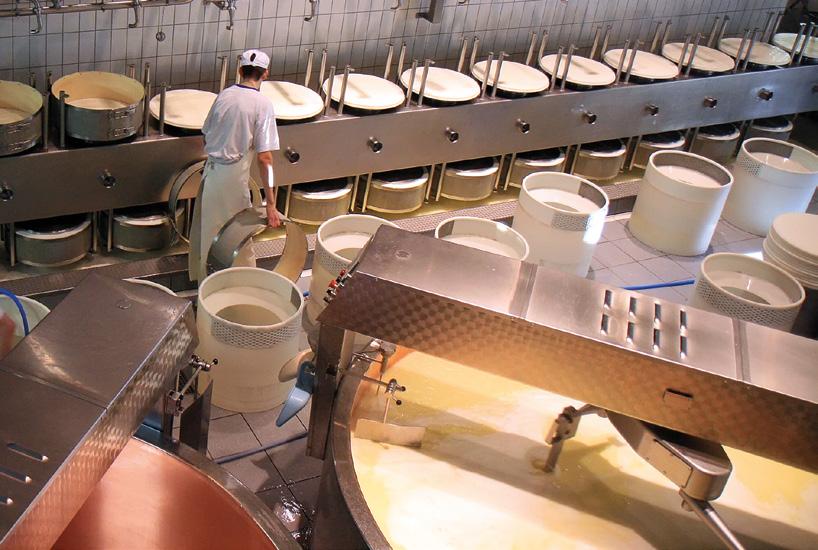
MARKET DYNAMICS
Drivers: growing demand for dairy products
The escalating demand for dairy products is a key driver fueling the growth of the dairy processing equipment market. Changing dietary preferences and an increasing awareness of the nutritional benefits associated with dairy consumption propel the demand for diverse dairy products. Moreover, lifestyle shifts, including a rising preference for convenience and readyto-eat dairy items, contribute significantly. The global popularity of dairy-based snacks and beverages further amplifies the demand. Additionally, evolving consumer trends favoring specialty and functional dairy products, such as probiotic-rich offerings, contribute to the market growth. To meet this heightened demand efficiently, dairy processors invest in advanced processing equipment to ensure enhanced production capabilities, maintain product quality, and comply with evolving hygiene and safety standards, collectively fostering the expansion of the dairy processing equipment market.
Restraints: increasing energy costs
Increasing energy prices amplify operational expenses for dairy processing facilities, impacting their overall profitability. Energy-intensive processes, such as pasteurization and refrigeration, substantially contribute to operational costs, prompting a need for more energy-efficient equipment. In response to environmental concerns, strin-
food processing 18 italian food & packaging technology - cvi (2024) - march
gent regulations also drive the adoption of sustainable and eco-friendly practices, influencing dairy processors to invest in energy-efficient equipment. The focus on reducing the carbon footprint and adhering to stringent emission norms adds an additional layer of complexity. As a result, dairy processors navigate the delicate balance between technological advancements and cost-effective solutions to mitigate the impact of rising energy costs, thereby influencing the trajectory of the dairy processing equipment market.
Opportunities: support by the government and non-government bodies in terms of funding for SMEs and startups
Government and non-government support for funding small and medium-sized enterprises (SMEs) and startups in the dairy sector presents a significant opportunity in the global dairy processing equipment market. Initiatives like the Common Agricultural Policy (CAP) in the EU and the Dairy Business Innovation (DBI) Initiatives in the US play a crucial role in fostering innovation, development, and expansion within the dairy industry. The availability of funding through schemes such as the School fruit, vegetables and milk scheme, direct payments under the European Agricultural Guarantee Fund, and the European Agricultural Fund for Rural Development provides financial backing for small companies to invest in advanced dairy processing equipment.
In the US, the DBI Initiatives offer direct technical assistance
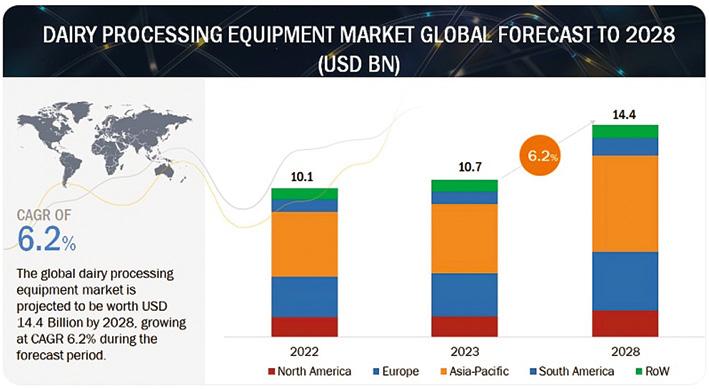
and subawards to dairy businesses, encouraging diversification, promoting innovation, and supporting regional milk production. This financial support becomes an opportunity for SMEs and startups to modernize their operations, specialize in niche dairy products, and enhance their value chain. The allocation of approximately USD 23 million for DBI projects creates avenues for dairy businesses to invest in state-of-the-art processing equipment, facilitating improved efficiency, quality, and sustainability. Overall, government and non-government funding initiatives act as a catalyst for the growth and technological advancement of SMEs and startups in the global dairy processing equipment market, fostering a more competitive and dynamic industry landscape.
Challenges: high capital investment
High capital investment poses a significant challenge in the global dairy processing equipment market, affecting both
existing players and potential entrants. The dairy industry demands sophisticated and technologically advanced equipment to ensure efficiency, quality, and compliance with stringent hygiene standards. Procuring and implementing such cutting-edge machinery requires substantial financial resources, creating a barrier to entry for smaller enterprises and startups. High capital expenditure is particularly challenging for businesses in developing regions or emerging economies, limiting their ability to adopt state-of-the-art processing equipment.
For established players, the need to continually invest in upgrading and expanding their processing capabilities adds financial strain. The dairy processing industry is evolving rapidly, with advancements in automation, sustainability, and quality control necessitating ongoing investments. This creates a competitive landscape where companies with limited capital may struggle to keep pace with their well-funded counterparts, impacting their overall market standing.
food processing italian food & packaging technology - cvi (2024) - march 19
Moreover, the dairy sector often operates on tight profit margins, making it challenging for businesses to allocate substantial funds for capital investment without compromising their financial stability. High capital requirements can hinder the modernization and optimization of processing facilities, affecting operational efficiency and limiting the adoption of eco-friendly and energy-efficient technologies. In essence, the challenge of high capital investment acts as a potential roadblock to the widespread adoption of cutting-edge dairy processing equipment, influencing the market dynamics and competitiveness within the industry.
Based On Type, The Pasteurizers Segment Is Estimated To Hold The Largest Market Share During The Forecast Period Of The Dairy Processing Equipment Market
Pasteurizers are poised to hold the largest share in the dairy processing equipment market due to their crucial role in ensuring the safety and quality of milk products. Pasteurization is a key process in the dairy industry, involving the heating of milk to specific temperatures to eliminate harmful bacteria, thereby preventing diseases and enhancing the shelf life of milk. The significance of pasteurization in sterilizing raw milk is paramount for delivering high-quality and safe dairy products to consumers.
In dairy processing plants, pasteurization machines play a vital role in the destruction of
tubercle bacillus and the thermal destruction associated with cream separation. The versatility of pasteurizers allows for two main processing methods: longterm low treatment temperature and short-term high-temperature treatment. The low-temperature treatment, typically around 60 degrees Celsius for half an hour, is the preferred option due to its effectiveness in preserving milk quality.
Moreover, pasteurization machines are integral in treating bagged milk, ensuring the collection of fresh milk at low temperatures for superior quality and extended shelf life. The complexity of the process underscores the importance of these machines in maintaining the overall hygiene and quality standards of the dairy processing industry.
Given the paramount role of pasteurization in ensuring milk safety, quality, and longevity, pasteurizers are expected to dominate the dairy processing equipment market, reflecting their indispensable position in the overall dairy production process.
Asia Pacific To Have The Fastest Growth In The Dairy Processing Equipment Market
Asia Pacific commands the largest share in the global dairy processing equipment market, driven by the substantial contributions of key players like India and China. India’s status as the leading global milk producer, contributing 24% of the total milk production, underscores its pivotal role in the regional and global dairy industry. The signif-
icant growth of the dairy sector in India, with a remarkable 61% increase in milk production over eight years, positions the country as a major market influencer.
According to the Dutch Bank, in China, the self-sufficiency rate for dairy products fluctuates between 70% and 80%, necessitating a focus on imports and domestic production to meet rising demand. The Chinese government’s initiatives, such as the five-year plan for the dairy sector, emphasize the promotion of large- scale modern dairy farms and digital transformation. The concentration of milk production in regions like Inner Mongolia and Heilongjiang further consolidates China’s position in the Asia Pacific market.
The growth in the Asia Pacific dairy processing equipment market is also fueled by the shift in food security awareness, geopolitical considerations, and strategic government actions. With a rising percentage of dairy herds on farms with more than 1,000 head and a focus on improving breeding capabilities and vertical integration, Asia Pacific is poised to dominate the global dairy processing equipment market, reflecting the region’s dynamic and evolving dairy industry landscape.
Key Market Players
The key players in this market include GEA Group (Germany), SPX Flow (US), Tetra Laval (Switzerland), ALFA LAVAL (Sweden), JBT (US), Bucher Industries (Switzerland), Krones (Germany), and The Middleby Corporation (US).
www.marketsandmarkets.com
food processing 20 italian food & packaging technology - cvi (2024) - march
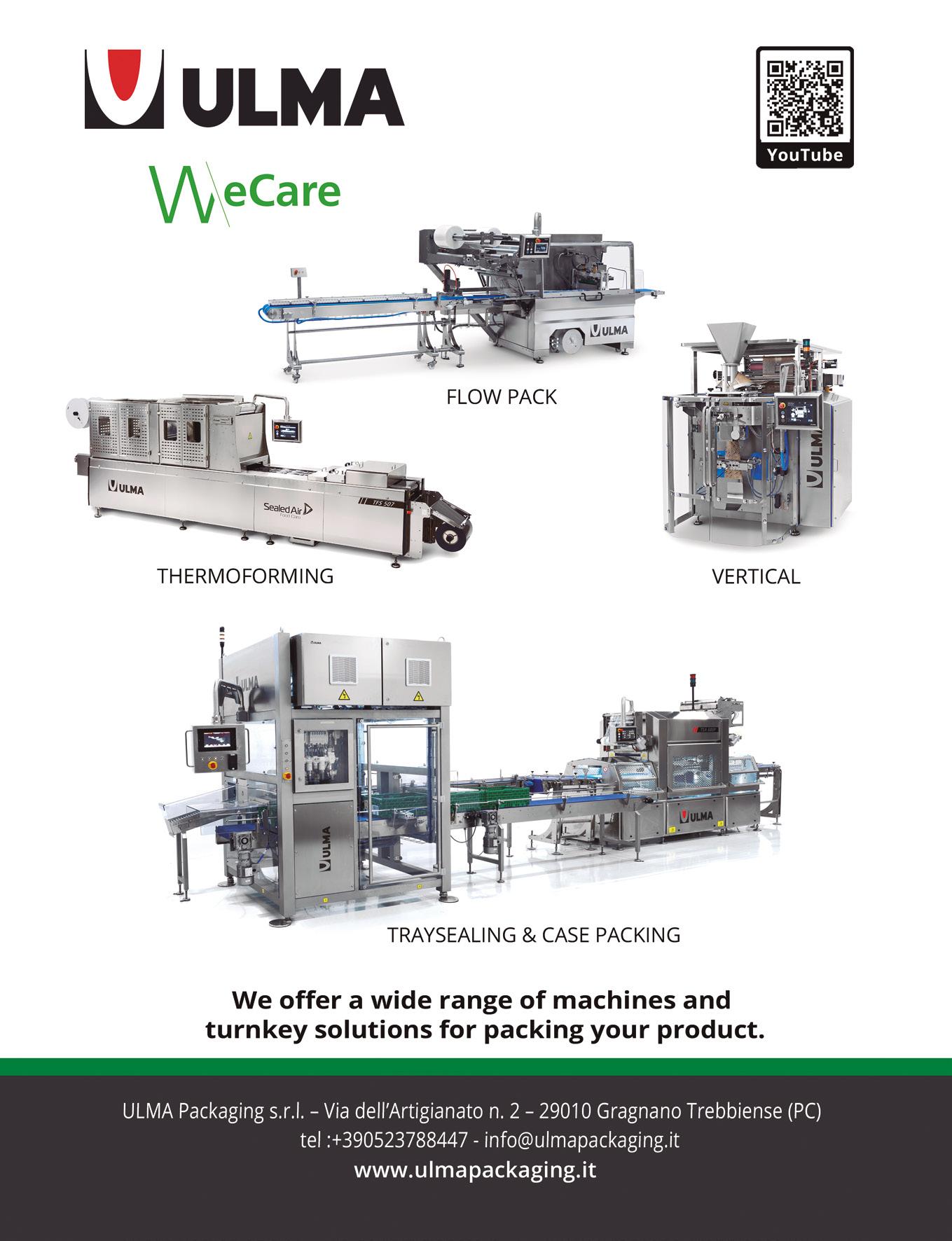
Sarp at Anuga FoodTec
It’s trade fair season once again, a time for personal exchanges and intensive networking, to showcase the business and technologies in an even more innovative manner, pushing the boundaries of progress. Join Sarp and experience their latest advancements in food processing technology at Anuga FoodTec from March 19th to 22nd in Cologne.
Anuga FoodTec is the most important information and business platform for new concepts and innovative developments in the international food and beverage industry. It is the world’s only supplier fair that competently covers all aspects of food and beverage. For the first time in 2024, as a new sector, there will be an exhibition area for environmental technology and energy.
For Sarp, this event is a prime opportunity to showcase its diverse range of technologies spanning food processing and complete lines for pasta technologies, including the Spiral Division for cooling, freezing, pasteurizing, proofing, and cooking various food products such as bakery items, dairy products, processed fruits and vegetables, meats, ice cream, desserts, and beverages.
At Anuga, the company will be highlighting its Cooling and Freezing Spiral for Bakery Products, capable of reaching temperatures as low as -40°C. The engineers will analyze your product’s characteristics and recommend the most suitable spiral freezing tunnel, custom-designed for your requirements. Sarp offers flexibility in spiral
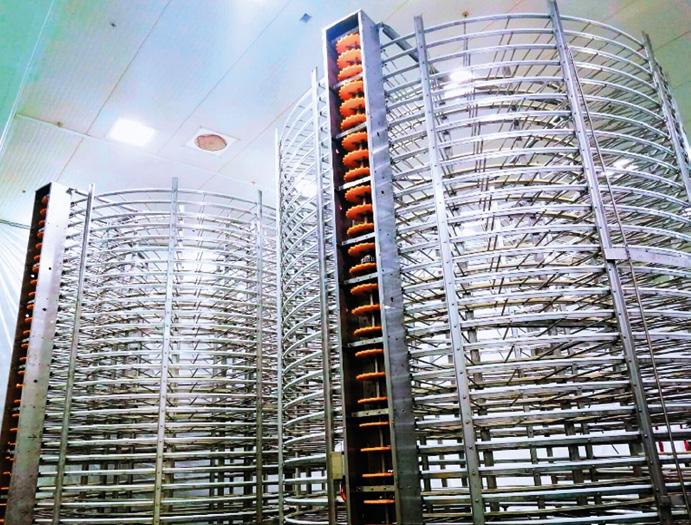
shape (circular, oval, eight), conveying speed, loading and unloading systems, as well as inlet and outlet positions of the product, and belt direction.
The cooling treatment can occur at room temperature or, with the use of an insulating cell, at a controlled temperature. Through airflow studies conducted by Sarp, it ensures uniform temperature distribution in the environment, expediting the heat treatment process and enhancing its effectiveness in preventing moisture build-up. Sarp is committed to energy efficiency, providing customers with the option to combine insulated cell advantages with evaporation systems that utilize and filter external air, optimizing air recirculation and reducing heat treatment energy requirements.
Visit Sarp booth at D11-Hall 10.1 and discover all the specific construction details that differentiate their machines, including the welded cell, washing system, and numerous belt options tailored to your production needs.
Here is where Sarp will be displaying for the rest of the year: Appex, Melbourne, AU 12-15 March 2024
Pastaria, Firenze, IT 20-21 May 2024
Fispal Tecnologia, Sao Paolo, BR 18-21 June 2024
Anutec, Mumbai, IN 28-30 August 2024
Gulfood Manufacture, Dubai, UAE 3-5 November 2024
(Sarp - Via Montebelluna di S. Andrea 43 - 31033 Castelfranco Veneto - TV - Italy - Tel. +39 0423 482633 - email: sarp@sarp.itwww.sarp.it)
food processing 22 italian food & packaging technology - cvi (2024) - march
Cooling and freezing spiral equipment for bakery products (Sarp).
The world of sieving
Emilos passion for sieving was born at the end of the 70’s and is the result of the will and commitment of Luigi Solimè, the founder. He has always been characterized by intuition and enthusiasm, thanks to which the company has been able to establish itself in the world of sieving.
The structure is characterized by a strong flexibility, which allows to obtain significant immediate results. Direct contact with the customer’s problems constantly stimulates the planning.
In Italy, Emilos offers free sieving tests, thanks to which it is possible to precisely define the type of vibrating screen most

suitable for the result desired by the user. With its processing cycle it is possible to create entirely customized vibrating screens,
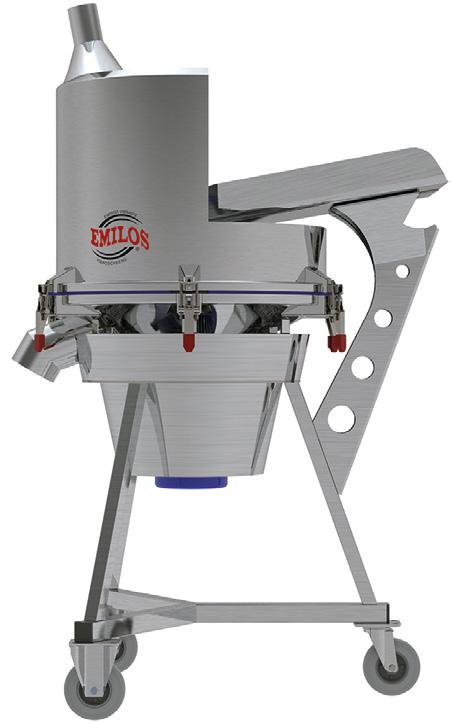
offering an absolute quality, and always guaranteeing the best functioning of the tailor-made vibrating screen; in fact, loyalty of the customers is an element of pride.
The range of the vibrating screens goes from 450 to a maximum of 1,800 mm diameter and they are capable to deal with very difficult sieving and high hourly flow rates, thanks to the special vibrators designed to work continuously 24 hours a day, 365 days a year.
The strengths that distinguish Emilos are the design and manufacture of customized vibrating screens, the quality of the materials used, the precision of the workmanship, the longevity of the machinery produced, and the short execution and delivery times; moreover, it’s always been focused on Made in Italy and each of the vibrating screens is entirely manufactured in-house.
(Emilos - Via Della Costituzione
6 - 42025 Cavriago - Re - ItalyTel. +39 0522 575010 - email: info@emilos.it - www.emilos.eu)
food processing italian food & packaging technology - cvi (2024) - march 23
SV series vibrating screen (Emilos).
CRX series vibrating screen (Emilos).
The future of chocolate and fat creams: Tecno3 and the P10S
In the increasingly competitive landscape of chocolate and fat cream production, efficiency and innovation are not only desired, but essential. Tecno3 , at the forefront of processing technology, presents the P10S plant, a revolutionary solution that meets modern requirements with optimal performance and respect for the organoleptic characteristics of the products.
P10S: a plant that rewrites the rules of continuous refining
The P10S is not a simple plant; it is a guarantee of quality, efficiency and precision. Tecno3 has
focused its expertise on creating a system that combines grinding and refining in a single process. This approach not only simplifies the workflow, but also ensures a significant reduction in physical footprint and considerable energy savings.
The machine consists of three distinct stages, each designed to optimise a specific part of the process:
• Pre-refining with two horizontal cylinders: this stage prepares the product for refining, ensuring that the grain size is ideal for subsequent stages.
• Vertical roll refining: further refines the product, improving consistency and particle size distribution.
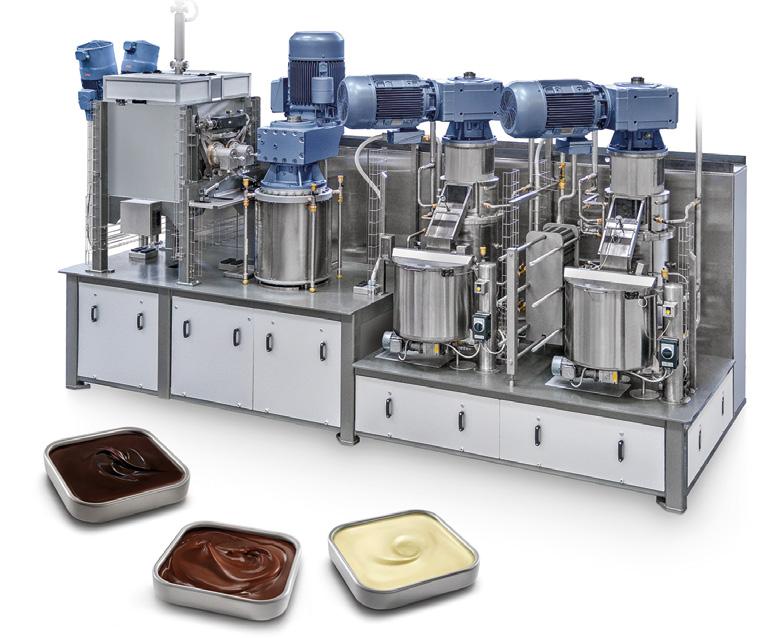
• Ball refining: last but not least, it guarantees maximum fineness of the product, preserving its organoleptic and sensory qualities.
The beating heart of the plant is without doubt the intelligent process control.
Tecno3 has implemented a monitoring and management system that regulates critical parameters such as product flow rate, rotor speed, working temperature and internal pressure. This not only guarantees the quality of the final product, but also prevents the formation of excessively fine particles, preserving ideal rheological properties.
Tecno3: an ideal partner for reliability and innovation
Over and above the P10S, Tecno3 stands out in the industry for its ability to innovate and offer solutions that arise from actively and deeply listening to the needs of each customer. That is why the company speaks not only of systems, but of complete processes customised to each production request.
In this context, Tecno3’s P10S represents both a further step forward in the field of chocolate and fat cream processing and a symbol of the company’s progress and innovation.
(Tecno3 - Via Mastri Cestai 2 - 12040 Corneliano d’Alba - CNItaly - Tel. +39 0173 610564 - Fax +39 0173 619494 - e-mail: a.mattis @tecno-3.it - www.tecno-3.it)
food processing 24 italian food & packaging technology - cvi (2024) - march
P10S grinding and refining plant (Tecno 3).

GRINDING MILLS AND PLANTS
ITALO DANIONI manufactures grinding mills, mixers and crushers since 1918. The Company also produces closed circuit, refrigerated and conditioned and explosion proof plants for products in powder Customers have at their disposal a test room with industrial machines for verification of functioning and capacity
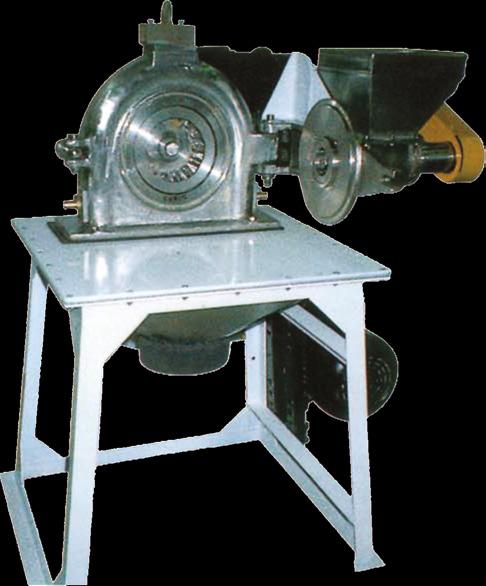


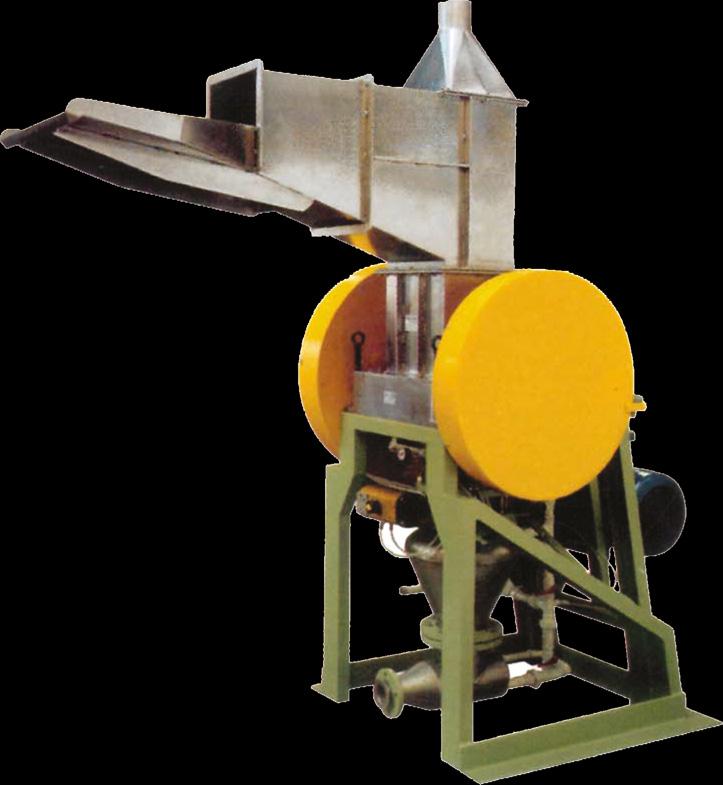

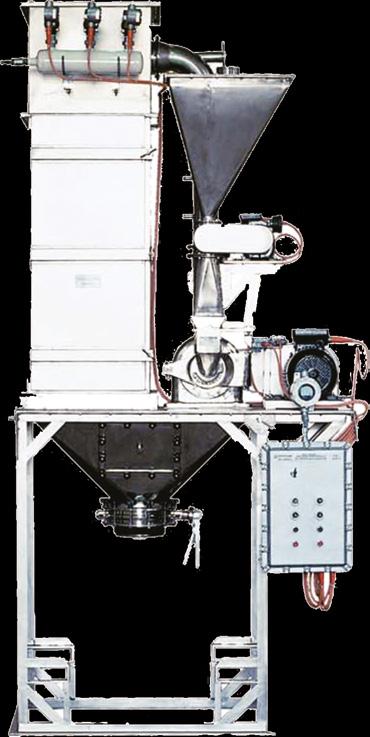

Via Mecenate, 78/b 20138 Milano - ITALY Tel. +39 02 504095 +39 02 504195 Fax +39 02 5062646 info@danioni.com w w w . d a n i o n i . i t Upgrading to existing installations
How to design plant protein-based sausages
The synergistic effect of lactic acid fermentation and high-moisture extrusion processing of pea protein on the microbiological and sensory properties of plantbased sausages was investigated by Finnish Researchers.
Plant-based sausages were formed by combining ferment-

ed pea protein concentrate (PPC) biomass with high-moisture extruded pea protein isolate (PPI). Pea protein concentrate (PPC) was fermented with Lactococcus lactis subsp. lactis and Lactiplantibacillus plantarum to improve the perceived structure, texture, and flavour (specifically via expression of glutamic acid which is connected to umami flavour) of plant-based sausages. The sausages were prepared by stuffing the mixture of extruded PPI and fermented PPC (addition level 70:30) inside vegetarian casings followed by steam cooking. After preparation and cooking of the sausages, a trained sensory panel evaluated the inten-
sities of ten selected attributes defining the flavour, odour, colour, and texture. In addition, dry matter content, acidification, microbial quality, and glutamate contents were analysed. The results published in LWT - Food Science and Technology journal demonstrated that fermentation decreased the pea-like odour and improved the texture of the sausages. In addition, yeast-like odour and umami taste were observed.
The study was able to demonstrate novel clean-label processing approaches by combined fermentation and extrusion to generate in-situ meat-like flavour and texture based on plant protein ingredients.
Ohmic heating-based extraction of biocompounds from cocoa bean shell
Cocoa bean shell (CBS), a by-product of the chocolate industry, was employed as substrate for the sustainable recovery of bioactive compounds using ohmic heating (OH). In a Portuguese study published in Food Bioscience journal, the total phenolic content and antioxidant activity of the treated CBS were optimized by experimental design.
Maximum extraction of antioxidant phenolic compounds (23mg GAE/g CBS) was obtained at 67°C, 50 min and 44% ethanol (v/v). The antioxidant activity of the extracts obtained under of the central point conditions
was 284.5muM Fe2+/g extract (FRAP) and 36.4muM TE/g extract (DPPH). The use of OH increased the extraction of bioactive phenolic compounds when compared to the conventional process (CH) (approximately 40%). An increased on the chemical antioxidant activity was also observed, ranging from 4 to 20%. The metabolic activity of the extracts obtained by the two methods (OH and CH) was evaluated in non-tumoral (HEK293T and L929) and tumoral cell lines (Caco-2, HT-29, and HeLa). The CBS extracts presented low toxicity in non-tumoral cells and ROS preventive effects.
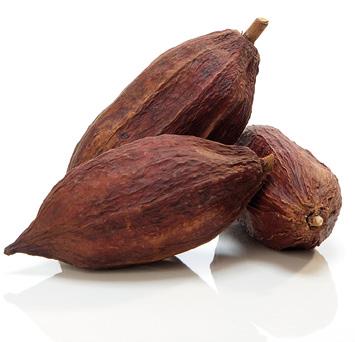
These characteristics make them ideal to be used in food processing and formulation, as well as nutraceutical products due to their antioxidant protection. The use of OH results in an extract with higher phenolic content and higher antioxidant activity and low environmental impact.
food processing 26 italian food & packaging technology - cvi (2024) - march
The influence of hot-air mechanical drying on the sensory quality of coffee
The main aim of this Colombian study published in AIMS Agriculture and Food journal was to evaluate the impact of mechanical drying on the sensory quality of specialty coffee produced on three Colombian coffee farms.
The technique involved a study of the coffee bean drying process parameters, such as temperature (35°, 45° and 55°C), airflow (100 m3/min.m2) and thickness (0.2 m) for mechanical drying, vs conventional drying in the open sun until 11% of moisture content was reached. For mechanical drying, the effective diffusion coefficient, electrical conductivity and drying kinetics were evaluated. A sensory test was performed for three storage periods (3, 6 and 9 months) using the Specialty Coffee Association (SCA) protocol. The results
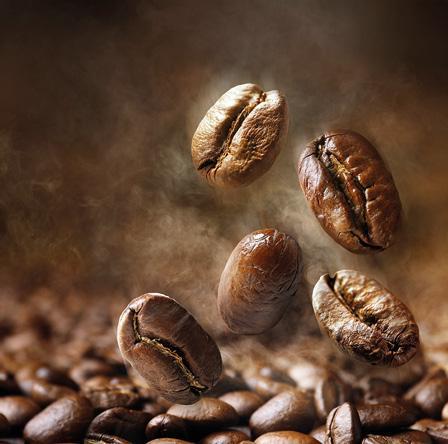
showed that the effective diffusion coefficient varied from 3.21 to 8.02 x10-7 m2/s for mechanical drying and from 4.21 x10-11 m2/s for drying in the open sun. The time drying time was established at 20.35 ±0.06, 29.10 ±0.09 and 71.52 ±0.11 hours for mechanical drying at 55°C, 45°C and 35°C respectively and 54.48 ±11.37 hours for drying in the open sun system. The average moisture content at the end of all drying operations was 12.5%. Electrical
conductivity rose from 11.71 to 16.86 microS/cm.g at drying temperatures ranging from 35 to 55°C. The sensory test revealed that storage duration had no effect on the quality of the coffee drink when in touch with the drying process, with mechanical drying yielding higher sensory ratings. The coffee beans were dried at 55°C, yielding coffee samples with SCA scores more than 85 points.
In overall, it is determined that the convective mechanical drying method is a viable approach for the processing of specialty coffee beans since it allows for the retention of high-quality sensory qualities, allowing it to command higher market pricing.
Effect of pulsed electric field treatment on beef cuts properties
The effect of pulsed electric field (PEF) treatment on beef cuts was performed by Czech Researcher based on two consecutive experiments and the results were published in the Innovative Food Science and Emerging Technologies journal. In the first experiment, the effect of PEF treatment (100 pulses, 5 mus, 100 Hz) of different voltage intensities (0.5; 0.75; 1.0; 1.5; 2.0; and 4 kV.cm-1) was evaluated in M. psoas major (PM). A significant effect of treatment on meat colour, texture, drip loss, and electrical conductivity was confirmed (P < 0.01), but no effect on pH value, and water activity. The electrical voltage of 0.75 kV affected the beef cuts most significantly, due to this finding the second ex-
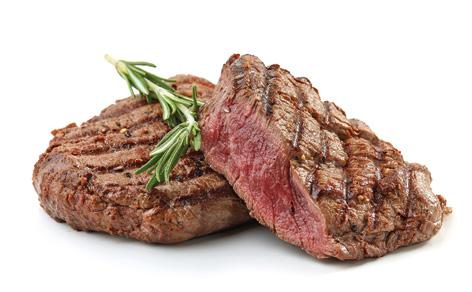
periment was designed. Colour, texture, cooking loss, and drying were evaluated to assess the number of pulses of PEF treatment on M. longissimus thoracis (LT), M. psoas major (PM), M. semitendinosus (ST), and M. brachiocephalicus(BC).
In addition to significant effect on colour and cooking loss, PEF has accelerated the drying process of LT cuts (P < 0.01).
food processing italian food & packaging technology - cvi (2024) - march 27
New technology to reduce pathogens in intact eggs
Salmonella bacteria causes about 1.35 million infections, 26,500 hospitalizations, and 420 deaths in the United States every year. Despite their appearance in everyday meals and snacks, the truth is that raw
less than 3 percent of commercial eggs are pasteurized in the United States. Conventional thermal pasteurization of intact eggs is usually a long process that involves submerging eggs in hot water for more than 57 minutes
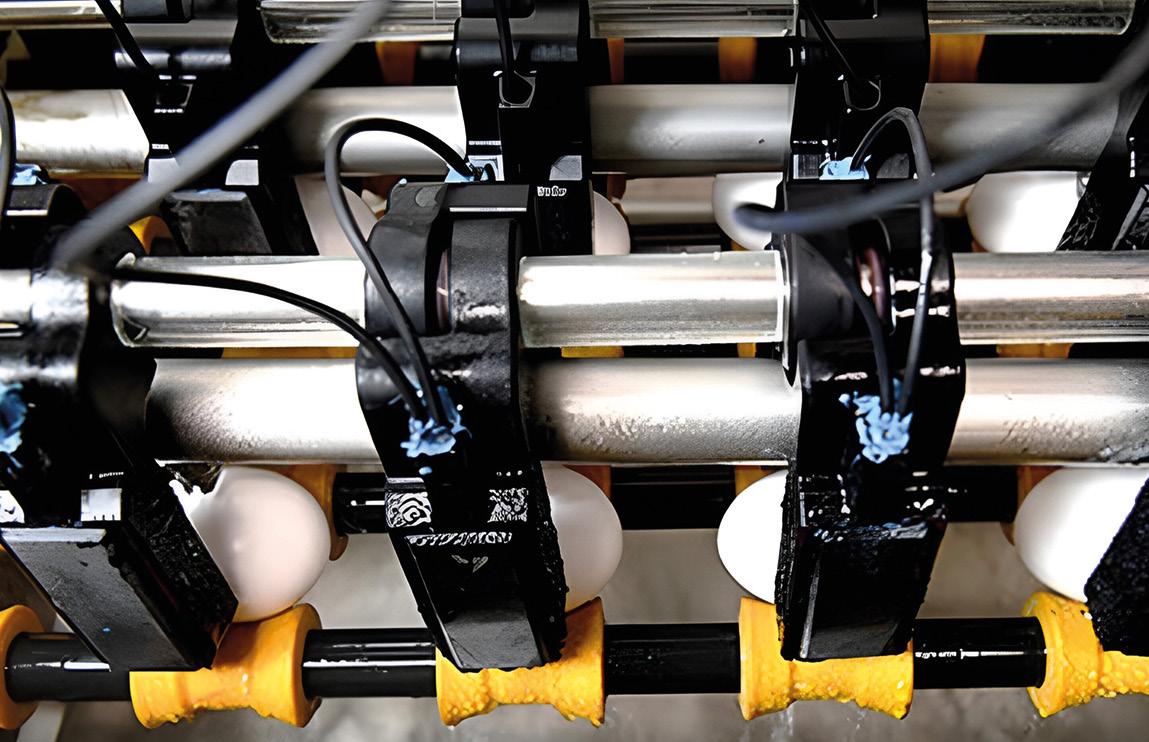
eggs and egg products can carry Salmonella and cause foodborne illness and outbreaks, and even death, in some circumstances. But researchers at the U.S. Department of Agriculture (USDA) recently found a way to combat this through Radio Frequency (R.F.) technology.
A simple solution to foodborne pathogens in eggs would be to pasteurize all raw eggs before they are consumed; however,
to inactivate Salmonella cells. Researchers at the Agricultural Research Service›s (USDAARS) Eastern Regional Research Center in Wyndmoor, Pa., used a novel thermal technology that pasteurizes eggs and inactivates Salmonella cells with a short processing time.
During the study, the water molecules inside the egg rotate and align with the RF instrument’s electric field. This molecular fric-
tion causes the liquid inside the egg to heat up quickly and subsequently reduce Salmonella by 99.999% within 24 minutes. The R.F.-processed eggs were transferred to the refrigerator and kept at 7°C for seven days to simulate the commercial cold chain temperature.
“After treatment with the system, no intact Salmonella or sub-lethal Salmonella cell remnants were recovered, and no cell recovery was found in the R.F.treated eggs when stored at retail refrigerated temperature,» said USDA-ARS Research Food Technologist Daniela BermudezAguirre. “The egg quality, such as the color and other parameters, were also preserved through the processing.”
This technology has shown several advantages when used in food, all without a negative effect on food quality. Statistics also show that Americans consumed a total amount of 93.1 billion eggs in 2023. So, this is a promising advancement for small farmers or egg processors and can ensure food-safe eggs while minimizing Salmonella. Consumers will also benefit from this technology since it preserves the quality of the eggs that can be used for special markets such as nursing homes, hospitals, or schools.
ARS researchers will continue to develop this technology’s capabilities and expect it to be commercially available in the near future.
www.ars.usda.gov
food processing 28 italian food & packaging technology - cvi (2024) - march

PACKAGING TRENDS
Packaging and sustainability: alternative materials and flexible machine concepts
The current packaging development trend is evident at ProSweets Cologne: Wherever it is possible to dispense with plastic for packaging, paper or cardboard are being used instead. There will be many examples of this during the Sweet Week at the Cologne fair grounds, especially in the halls of the co-staged ISM, the world’s largest trade fair for sweets and snacks. As a duo, ISM and ProSweets Cologne, represent the entire industrial value chain of the international sweets and snacks industry. Increasing the recyclability and reducing the weight of the packaging are important aspects that are at the top of the agenda of the sweets industry. During the Sweet Week the industry’s most important producers, suppliers and decision-makers all engage in an exchange in one location at the same time - to bring about synergies in the areas of networking, knowledge transfer and business.
Recyclable and functional alternatives to petrochemical plastics of the linear economy
“We very much welcome the consumers’ increased awareness for sustainability,” confirmed Prof. Dr. Markus Schmid. “This awareness leads to a heightened interest in environmentally-friendly packaging. However, it is important that well-founded decisions are taken concerning the choice of material. We often see that well-intended initiatives lead to hasty solutions without their functional restrictions and the actual ecological footprint being taken into
full consideration. In our work at the Sustainable Packing Institute (SPI) at the Albstadt-Sigmaringen University we strive to develop holistic solutions that are both functional and sustainable. Our aim is to improve the life cycle assessment of bio-based plastics, i.e. by using residual plant matter and thus being able to offer really more sustainable packaging materials.” The recent successes achieved in current and completed projects will be presented interactively in the scope of the Sustainable Packaging Special Show in Hall 10.1 during ProSweets Cologne.
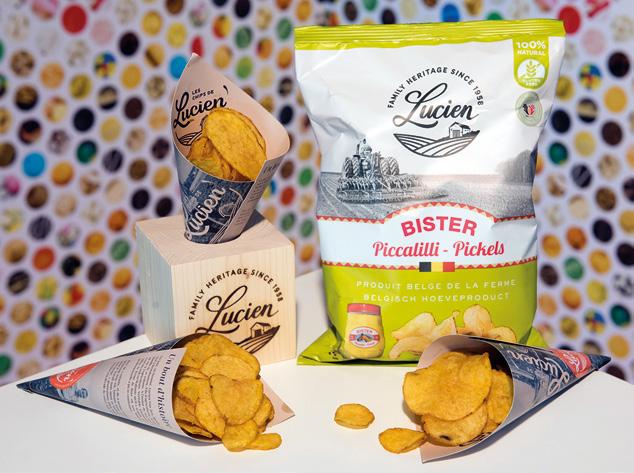
30 italian food & packaging technology - cvi (2024) - march
Peter Désilets, Chief Operating Officer of Pacoon Sustainability Concepts GmbH, knows which materials and technical innovations promote the change process. Whether for jelly items, toffee, caramel or bonbons: Whilst the consumers are pleased about the huge variety at the point of sale, the sweets and snacks manufacturers have to find the right interplay between packaging material and the packaging technology for their products. Materials that display the best possible machinability from the start are the prerequisite for this,” according to the expert. Especially in the concept phase of a new machine there is a lot of scope for designing the packaging with sustainability in mind. Fibre-based packaging is a preferred and in many respects forward-looking option for Désilets: “As a contact person for the companies we are presenting among others selected samples of fibre-based packaging at the Sustainable Packaging Special Show.”
Flexible machines for a wide variety of packaging
The trend towards paper-based packaging and monomaterials made from plastic is clearly noticeable among the machine builders who are exhibiting at the fair grounds in Cologne. They are supporting the producers in switching over to recyclable alternatives with innovative technologies that enable more economical cuts, improved material utilisation and optimised formats. Solutions that are found at ProSweets Cologne also guarantee perfectly sealed packaging in the case of very thin films made of polypropylene or polyethylene. In this way, stand-up pouches for snacks can be recycled as a true “single material solution”. Schubert offers its customers more flexibility for transverse sealing with the box motion unit in the Flowpacker, for example. The ultrasonic method makes it possible to seal more hermetically overall because the seam displays a consistent high quality across the entire width. Thick films that require longer sealing times can be easily processed as well as recyclable tubular bags made from monofilms or paper-based films.
In the meantime, sustainable materials can be processed in many other machines - what’s more with full format flexibility. An example of this is the Kliklok ACE by Syntegon. The carton erector folds paper trays without glue and thus enables conventional plastic trays to be replaced by paper-based materials. Moreover, sustainable packag-
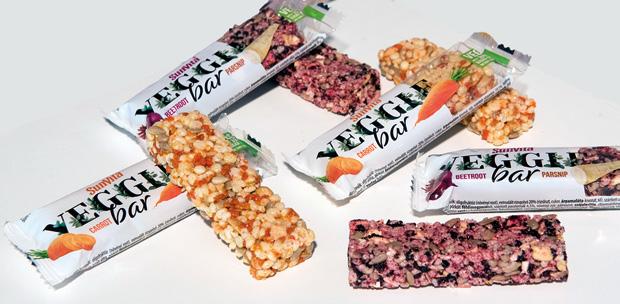
ing is demonstrated in concrete form by the FPC5 of Theegarten Pactec. The modular packaging machine for the production of bars in a tubular bag has been further developed so that paper-based packaging can be processed: On the one hand using a conventional cold seal process, but on the other hand also using a much more complex heat seal process. The machine has a capacity of 90 m per minute for paper-based packaging. That corresponds to 600 larger 40-g bars of chocolate per minute. And Loesch’s LTM-DUO fold wrapping machine is both flexible regarding the choice of format and the packaging material: From smaller bars through to 300-gram bars, from biofilm, to monofilm and composite material, through to aluminium foil, everything can be processed unproblematically. The outer wrapper of the bar of chocolate can be designed as a paper label from the stack or reel or also as a carton label. The examples show how the machine builders unite the themes sustainability and process integration with one other.
A look into the biocircular future
Hence the turnaround towards sustainable packaging solutions is in full progress – this will also be demonstrated in the Cologne exhibition halls from 28 to 31 January 2024. Hon. Prof. Dr. Sascha Peters, founder of the Haute Innovation Agency will be addressing scenarios for the markets of the future at ProSweets Cologne in his lecture entitled “Biocircular packaging for the sweets industry.” The solutions will also be presented in the scope of the Sustainable Packaging Special Show. The potential of regrowing alternatives to plastics is nowhere near exploited, he explained. Packaging that is made out of regrowing raw materials and residual organic materials are in demand. As a resource-saving alternative to con-
packaging trends italian food & packaging technology - cvi (2024) - march 31
ventional paper made of fresh fibres, grass paper is for instance developing into an ever-increasingly important packaging material. Depending on the usage it can replace the wood fibre content by up to 50%. “One can achieve an innovative advantage with alternative packaging,” according to Peters.
ProSweets Cologne is a trade fair for the entire industry-specific supply spectrum of the sweets and snacks industry. This ranges from the packaging of sweets and snacks and packaging technologies, to the raw materials and ingredients needed especially for the production of sweets and snacks, through to process technology. Secondary sections like refrigeration and air conditioning technology, operating and auxiliary equipment as well as the themes food safety and quality management for the sweets and snacks industry round off the portfolio.
www.prosweets.com
Food and packaging experts dare to look to the future
A breakfast in the year 2040: the porridge comes from a 3D printer which, thanks to your smart watch, has your current vital data and links it to a nutritionally optimized recipe. The basic raw materials required for this, such as rolled oats, nuts, and dried fruit, have already been processed for the 3D printer and are delivered to your home every week in a subscription box. But the user doesn’t notice much of this, “after all, thanks to technology, everything runs autonomously”, says Daniel Anthes, describing his scenario of the future. He is a startup founder, food expert, and keynote speaker at the Zukunftsinstitut.
Andreas Milk, who runs an agency for packaging design, has inspired Anthes to develop a joint “Future Food Trend Radar”. The two people from Frankfurt have been working on innovative and sustainable packaging materials for years. The radar not only sheds light on the future of eating and cooking, but also on packaging in the food sector.
Milk and Anthes venture a look into the future and predict that some packaging and systems, such as the compostable film Traceless and the Loop recycling project, will become game changers, while oth-
ers, such as packaging made from seaweed, may no longer have a secure future.
The radar provides inspiration and guidance on the question of which food and packaging materials and concepts – metaphorically speaking – are relevant today and will be tomorrow (2030 to 2040) or the day after tomorrow (from 2040). Companies from the food or packaging industry can have an individual radar created on this basis. They can therefore develop an individual brand image for the future and start the process for new products and packaging solutions based on this.
Change in Nutrition
“With our ‘Future Food Trend Radar’, we want to illustrate the transformation of nutrition in all its complexity and multi-layeredness and invite you to think about the future in an entertaining and inspiring way”, says Andreas Milk. “The focus is on the topics of food, kitchen, marketing, and packaging and, therefore, on what we eat, how and where we prepare and cook it, how and where we produce and transport the necessary food, and also on how we package it.”
Who Are the Game Changers?
In the Loop project, Procter & Gamble, Unilever, Nestlé, PepsiCo, Danone, and other consumer goods giants are working together on solutions to reduce waste. This is a completely new way of shopping in which reusable packaging plays the main role. Such naïve fallacy in which the packaging goes back to the retailer, are the future, say Milk and Anthes.
Further leaps in material reduction can be made with other approaches such as the “Flow Pack” from Adapa, which is already on the market. In Adapa’s innovative example, the special mono-material solution for improved recyclability is the decisive piece of the puzzle for contemporary packaging. The experts also see the edible protective layer Apeel as a gamechanger that is here to stay, it can be applied to citrus fruits or avocados, for example, and extends the shelf life of the food.
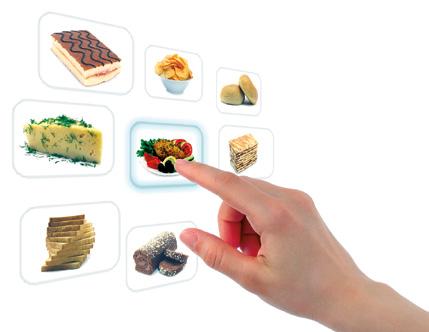
packaging trends 32 italian food & packaging technology - cvi (2024) - march
AS FAR AS YOUR EYES CAN SEE: INFINITE OPTIONS FOR PACKAGING FOOD. BROUGHT TO LIFE WITH SCHUBERT.



Being flexible is good, being fast and flexible is even better. Schubert packaging machines are leading the way. Intelligent control and precise robotics can now replace complex mechanics to ensure maximum flexibility in all packaging processes. In fact, 80% of the leading FMCG companies count on us and our flawless packaging combined with the lowest possible consumption. In line with our Mission Blue Sustainability Initiative: A winning proposition – for our planet and for you. www.schubert.group/en/food.html
MAR 19 - 22, 2024 HALL 7.1 BOOTH C-071 WELCOME
ANUGA FOODTEC COLOGNE
PACKAGING EQUIPMENT
Smart intralogistics: innovative solutions for a fully automated supply chain
Almost nothing can happen in the modern warehouses and cold storage facilities of the food companies without plastic containers. Durable pallet boxes and robust containers that guarantee hygienic transport and product-compatible storage are therefore just as much in focus at Anuga Food Tec as conveyor belts and mechanisms. Around 120 exhibitors present holistic intralo-
gistics solutions on the Cologne fair grounds.
The technology providers are embarking on new paths, particularly when it’s about improving the internal material flow: the goal is the seamless transition from production to distribution. Modern automation solutions are at the same time expanding the production facilities into storage and distribution centres thanks
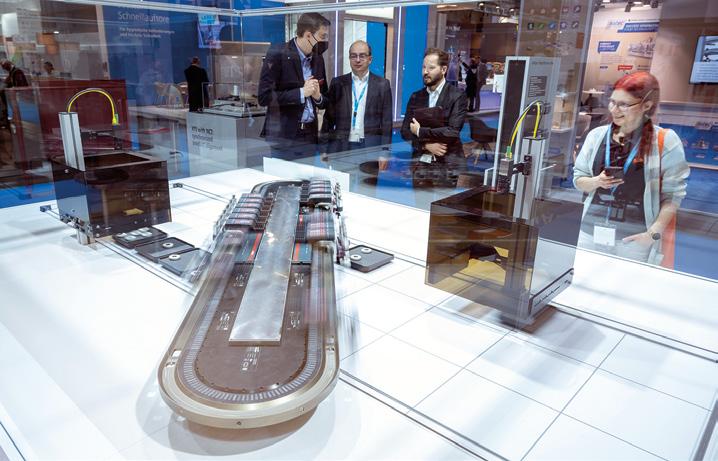
to artificial intelligence (AI). A theme that the lectures of the Main Stage Responsibility in Hall 9 also address, for example, in the framework of the panel discussion “Process optimisation in logistics” on 20 March 2024. Driverless transport systems thereby play just as important a role as picking and palleting solutions or conveyor systems that ensure optimal area use.
Systems for the “warehouse of tomorrow”
The warehouse of tomorrow must meet high requirements for connectivity. All of the systems used must not only communicate with one another, but also with external systems and processes. The requirements actually involved in practice are shown by a project realised by Anuga FoodTec exhibitor Westfalia for Spaichinger Nudelmacher. The intralogistics specialist replaced the forklifts used to date in the warehouse area of around 4,000 square metres in 2022 with an
34 italian food & packaging technology - cvi (2024) - march
automatic storage system for more than 9,000 pallets. Thanks to compact, multi-level storage, energy-saving throughput of around 80 load units per hour is possible in two to three-shift operation. The high-bay warehouse also manages with only two corridors for each 25 metre tall racking storage and retrieval vehicle with the load handling device Hub-Satellit with chain conveyors. The warehouse equipped with energy-efficient technologies is also an important step with regard to sustainability. The roof was equipped with a photovoltaic system and the use of packaging materials has been optimised through the automated processes. Behind this is an intelligent software that ensures permanent and reliable availability of goods.
A modern warehouse management system is capable of reproducing and administering all stocks of items, assortments and batches as well as their physical storage locations and units. Even the integration of pick-by-voice, pick-by-light and RFID applications as well as a forklift control system is no problem. In the context of showcases at Anuga FoodTec, exhibitors are showing how their hard and software solutions manage warehouse operations in the food industry and control the optimisation of work processes.
Agility and autonomy at close quarters
Presuming a high degree of automation, learning AI systems in intralogistics can optimise and accelerate all processes from receiving through stock transfer and picking to shipping. New
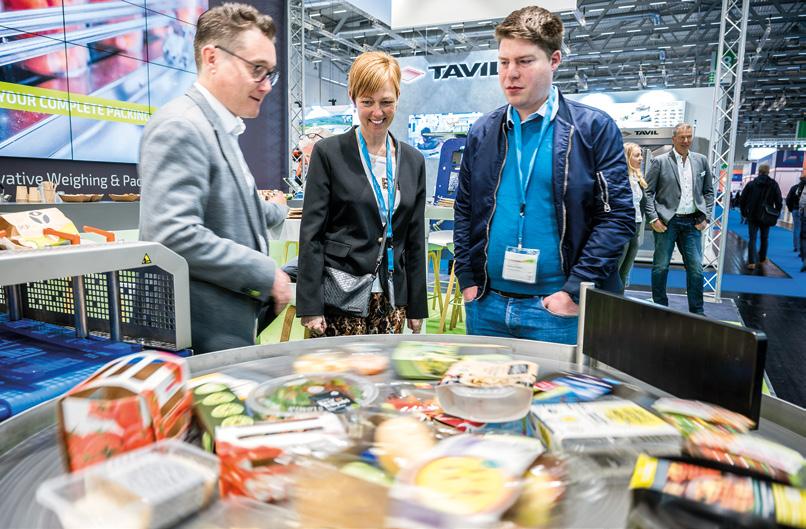
Technologies like 3D image processing for location determination allow driverless transport systems and autonomous mobile robots (AMR) to make intelligent navigation decisions on the basis of their environment. Cameras recognise and follow natural features of the environment, so that the vehicles adapt dynamically to their environment and can determine the safest and most efficient route to the destination. Dispensing points can thus be approached via a driverless transport system vehicle controlled with laser navigation, which gather the raw materials weighed in accordance with the recipe. Use between static reloading stations or conveyor belts is also possible.
Compact and autonomous counter-balance forklifts are an example of such a solution, which ensures smooth and error-free raw material automation. With a bearing load of up to 1,000 kilograms, various scanners and adjustable forks, they can be flexibly used for the transport of
europallets, racks and pallet cages both inside and outside. The autonomously navigating endto-end solutions with which food producers can optimise their intralogistic processes also include mobile robots (AMR). Up to one and a half tons of the most varied raw materials can be transported with an AMR platform to the production process, whereby this also impresses with exact positioning accuracy. Thanks to the QR code reader on top, they can identify their load, thus considerably improving traceability and operational efficiency. 3D cameras protect platform, load and equipment by reliably recognising obstacles in three-dimensional space.
The future of logistics
Scalable robotics solutions are advancing in the internal material flow. They increase efficiency and reliability and reduce operations costs. However, they currently often only play a supporting role
packaging equipment italian food & packaging technology - cvi (2024) - march 35
in small parts picking. With flexible and rerofittable pick-by-robot systems, intralogistics is provided with another alternative for unburdening people in picking activities—reliably and free of fatigue. The robots are thereby connected with the warehouse management system via WiFi and are directly issued the picking order by this. Shuttle systems can supply the robots with containers in the correct sequence and the required throughput.
Another solution approach to be discussed at Anuga FoodTec 2024 involves collaborating ro-
bots, so-called cobots, which provide support with automated picking. Various grippers and self-learning algorithms for object recognition enable them the handling of a broad spectrum of goods and use in various areas. They can also identify and sort out defective packaging or false products. All of this shows that automating intralogistics processes can be a significant factor for the success of food and beverage producers. In the coming spring, from 19 to 22 March, Anuga FoodTec will show which trends Intralogistics 4.0 will influence in
the food industry and how the solutions presented in Cologne can be optimally integrated into warehouse management systems.
Anuga FoodTec is the leading international supplier fair for the global food and beverage industry. Organised by Koelnmesse, the trade fair takes place from 19 to 22 March 2024 in Cologne and places the emphasis on the key theme of Responsibility. The professional and industry sponsor is the DLG, the German Agricultural Society. www.anugafoodtec.com
Innovative solutions for circular packaging
SMI Group is today one of the world’s largest manufacturers of bottling plants and packaging machines for food and beverages, household cleaning and personal care products, and chemicals and pharmaceuticals. To find out more about this reality, we put a few questions to Fabio Sisimbro, Sales Director of the group.
When did the company start?
Smigroup’s origins date back to the mid-‘70s, when Luigi Nava, father of the current owners, sets up a machine shop in San Pellegrino Terme (Bergamo). The craftsman’s small enterprise activity is initially represented by mechanical machining for third parties. Later, such activity is expanded to maintenance and repair of machinery and equipment employed in the bottling and packaging lines of the beverage industry.
What does the acronym SMI stand for?
In 1987, with the launch of the first shrink wrapper, the company SMI, acronym for Sistemi Macchine Impianti (Systems Machines Plants) is established. Since the year of its foundation, SMI activity has been aimed to

provide its customers with flexible, efficient, environmentally sustainable, easy-to-use and -monitor machines in order to improve the production cycle and make it more competitive; basically, automatic machines equipped with cutting-edge technologies that are rooted in key concepts behind Industry 4.0.
How has it evolved?
The whole activity of SMI revolves around the concepts of environment and sustainability, tradition and innovation, attention to the market requirements and search for cutting-edge technical solutions: all elements that contribute to enhancing continuous change.
But what makes SMI activity special is the passion inherited from family traditions and the capability to continuously innovate, give space to young people and anticipate market trends to
36 italian food & packaging technology - cvi (2024) - march
supply cutting-edge, reliable and sustainable packaging solutions. The SMI Group is today one of the world’s main manufacturers of bottling plants and packaging machines for beverage, water, beer, food.
The major corporations of the food & beverage sector are among the most important customers of the SMI Group: CocaCola, PepsiCo, Nestlé, Danone, Heineken, SABMiller, AB-InBev, Unilever.
Over 7,000 machines produced by SMI are installed in 130 countries around the world, where the company is present with its network of branches, providing efficient support and technical assistance.
SMI. is the first and main company of the SMI Group, composed of the parent company SMIGroup the subsidiary companies SMI, SMIPack, SMIMec, SMITec, Enoberg, SMIEnergia, SMILab, Sarco.Re.
Thanks to a workforce of 730 employees (126 of whom are outside Italy) and to 105,755 m² industrial facilities for offices and assembly units, in 2022 the SMI Group achieved a sales turnover of € 153 million.
Which is your mission?
Being innovative, reliable and sustainable in circular economy.
SMI is a customer-oriented company engaged in the design and manufacturing of high-tech bottling and packaging systems up to 50,000 bottles / hour, with the best quality/price ratio on the market.
Our main values are customers’ satisfaction. We provide our customers all over the world with innovative solutions that fully satisfy their requests in terms of efficiency, reliabili-

ty, flexibility and energy saving. Staff’s undertaking: The success of our business is based on the enthusiasm, engagement, ability, skillfulness, creativity, and spirit of initiative of each individual. Challenge of changes: We exploit all opportunities generated by changes, and we consider innovation a key factor for continuous improvement.
What’s sustainability for you?
SMI has chosen to protect the environment. The commitment of the companies of the SMI Group to projects involving en-
ergy saving and environmental protection has been significant. Innovation, reliability and sustainability represent the three key elements of the business strategy of SMI. All new development projects and plants realized revolve around such concepts, as demonstrated by the EBS ERGON stretch-blow moulders, compact, efficient, and environmentally sustainable systems for the production of PET and rPET (recycled PET) containers.
Behind the development of every new solution lies the idea of circular economy, an econom -
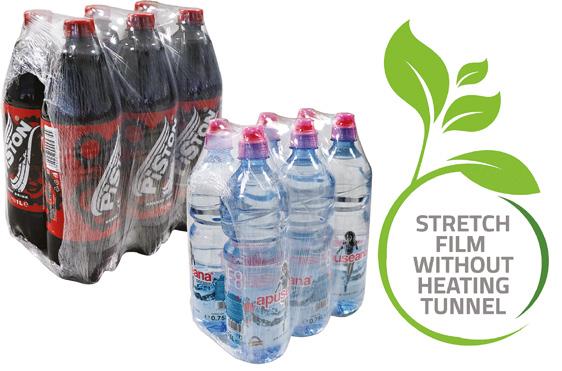
packaging equipment italian food & packaging technology - cvi (2024) - march 37
ic system designed to regenerate on its own. The use of rPET for the production of new bottles is the core of the concept of circular economy, that consists in collecting materials after they have been used and processing them so that they can be reused or recycled more times, eliminating waste and reducing the environmental impact of the packs, provided that efficient recycling and waste management systems are employed.
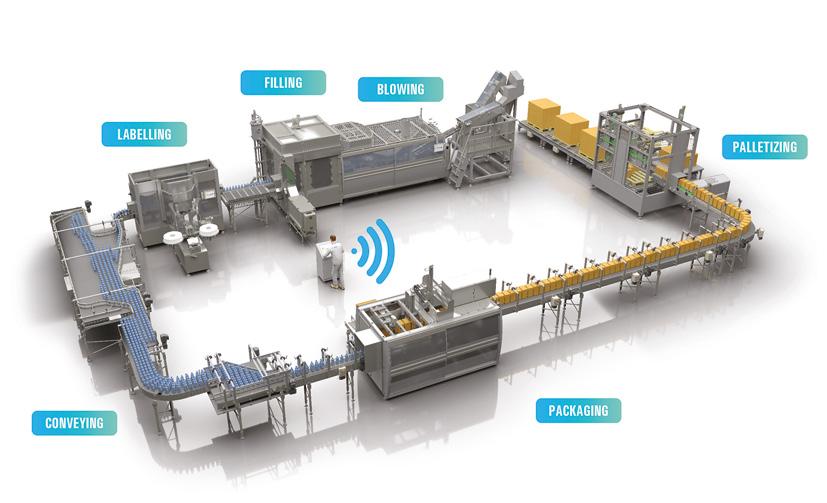
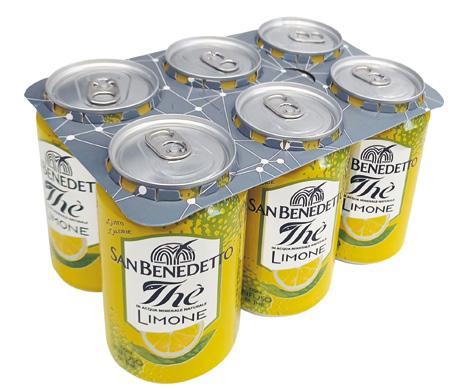
Another strategy that contributes to protecting the environment is based on the study of increasingly lighter containers that enable considerable plastic saving and fully comply with the environmental policies of the main beverage manufacturers.
In the end, the same type of commitment is adopted within the field of materials for the secondary packaging: on the one hand, SMI has developed innovative solutions for the cooling of the heating tunnel chain and heating tunnels equipped with panels with a dedicated ventilation, in order to process ul-
tra-thin LDPE shrink film (even less than 40 micron), maintaining the output unchanged in terms of mechanical features; on the other hand, SMI has launched on the market a packer to pack products in stretch film, that does not require the presence of a heating tunnel. Both the reduction of the film weight
and the absence of the heating tunnel are measures that go in the direction of reducing the environmental impact and operational costs for the customers.
What’s SMILab?
SMILab was established in 2008 as a spin-off of the R&D Department of the SMI Group in

packaging equipment 38 italian food & packaging technology - cvi (2024) - march
San Giovanni Bianco (BG). SMILab is a nonprofit research, training, and consulting center, that, in partnership with universities and businesses, carries out activities of scientific and technological research, testing, development, technological transfer and staff training.
Which are the main features of the latest blow-moulding machines?
The blow moulders of the latest generation from the EBS K/ KL ERGON range represent electronic rotary machines; each stretch-blow moulding station is fully driven by servomotors, that do not require the presence of mechanical cams, with subsequent advantages in terms of maintenance costs. Another key feature of the new series is the ultra-compactness of the machines, designed in such a way that the heating tunnel module (for the preform heating) and the carousel module (for the stretchblow moulding) lie on the same platform: this results in a reduction of transport (everything can be placed in a container) and installation costs (geometrical inspection is no longer required, as the modules are already aligned within the same platform). In the end, it is impossible not to mention some technological innovations that considerably contribute to reducing energy costs and the environmental impact, such as the Air Master double-stage air recovery system (that reduces by 40% the high-pressure air consumption and directly feeds the low-pressure circuit) or the heating tunnel ceramic panels that allow a better heating concentration, reducing the IR light emission and electrical consump-
tion. Another example is represented by the new design of the blowing valves, that, through the reduction of 50% of the dead volume, allows to optimize the stretch-blow moulding process in terms of performance and consumption.
For what concerns cardboard, SMI launched some months ago a new automatic packer for the application of a kraft cardboard pad into the upper part of cans. Among the distinctive features of this new type of packaging, for the moment suitable for cans:
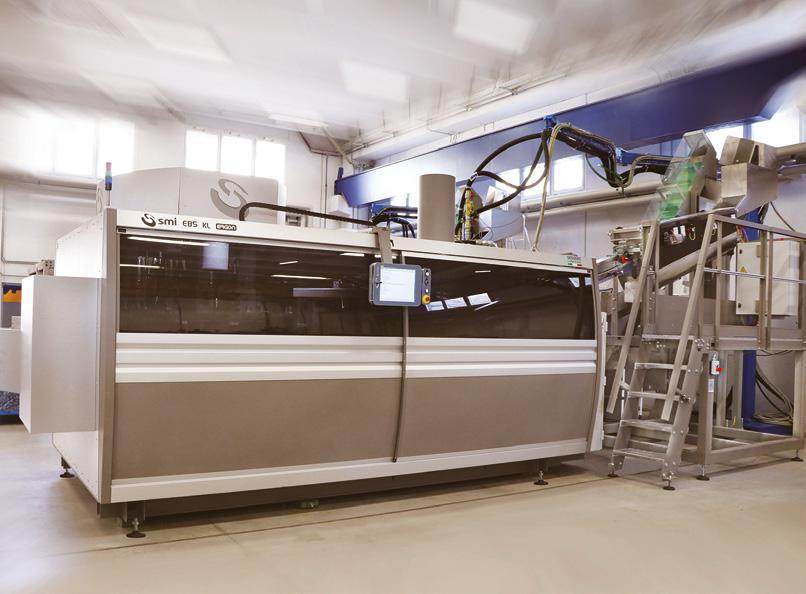
What has been the evolution of multipack packaging?
Today, environmental sustainability within the packaging industry results in two streams, not always antagonistic, but more and more often complementary: on one side, the willingness to continue to use plastics, but in a different way (recycling and lightening); on the other, the willingness to replace plastics with the use of cardboard, but in an aesthetically captivating way, such as kraft cardboard.
reduced amount of cardboard, no plastic, and no glue.
And which one for the future?
The times in which we are living are subject to a fast and continuous change in dynamics and market requests, that are difficult to predict even on a yearly basis. In this scenario, the pioneering nature of SMI in finding new solutions represents a key benefit. Therefore, I am sure that SMI will always be able to well interpret the new market requests.
Simonetta Musso
packaging equipment italian food & packaging technology - cvi (2024) - march 39
Innovative packaging solutions from Schubert for high-quality baked goods
The baked goods industry is facing a fundamental transformation. As are many other sectors, it is struggling under the currently challenging economic environment, with increased energy prices, supply bottlenecks and inflation. There are also fewer and fewer smaller traditional artisan bakeries, which are now being squeezed out by large industrial bakeries. Most market players are facing a shortage of staff. As a result, steps that used to be carried out manually now have to be performed by machine – and as quickly as possible. Although many baking processes have already been automated, this is not yet the case when it comes to packaging. Moreover, consumers want more and more product diversity and are demanding more sustainability. In this dynamic environment, bakeries of all sizes need reliable, expert support. As a packaging specialist with many years of experience, Gerhard Schubert GmbH is a partner that accompanies companies on the challenging path to profitability, efficiency and automation.
In addition to a fast-paced market environment, the challenges bakeries are facing today also lie in the production and packaging processes themselves. For instance, many baked goods are very sensitive when it comes to handling, while others have to be cooled throughout or packaged in a modified atmo-
sphere. As a rule, however, baked goods come directly from the oven. So the downstream packaging process needs to run as smoothly as possible, because the baking process cannot be interrupted. With its innovative top-loading machines and customised consulting services, Schubert is ideally positioned to

ensure precisely coordinated automated processes. This enables assortments with high production quantities as well as changing formats with small batches to be handled smoothly and seamlessly. By the same token, switching between conventional and more sustainable packaging materials also needs to be carried out as quickly as possible.
Packaging baked goods: Schubert machines guarantee flexibility
With Schubert, all processes ranging from primary to secondary and tertiary packaging can be combined into a modular yet compact linear system. Various packaging steps can be flexibly integrated into the overall process. The Flowmodul flow-wrapping unit can be incorporated into the TLM line at various points – for example, to pack freshly baked goods directly into flowpacks, or further along in the packaging process, for example, to wrap tray-packed baked goods into flowpacks. Packing into transport cartons and subsequent palletising can also be integrated into a Schubert TLM line.
packaging equipment 40 italian food & packaging technology - cvi (2024) - march
Pick & place robots pick up baked goods, group them into stacks and set them down with millimetre precision.

Pick & place robots: accurate and always precise
With Schubert, pick & place robots play an important role in the packaging processes. They pick up baked goods and place them into trays, cartons or thermoformed packs – with millimetre precision. They can achieve this thanks to the vision system developed in-house by Schubert, which, as a quality control system, reduces waste, cuts costs and significantly increases the efficiency of the entire packaging process. In addition to determining the exact position, the pick & place vision system ensures that baked goods that do not meet the quality specifications or are damaged are not picked up and further processed.
Moreover, thanks to their customised tools, the pick & place robots are extremely flexible when it comes to processing baked goods of different
consistencies, shapes or sizes. With the complete PARTBOX 3D printing system from Schubert Additive Solutions, bakeries
can quickly and easily produce the tools they need themselves using certified print jobs. Furthermore, the pick & place machines bring their strength to bear with various assortment configurations such as mixed biscuit packs: The baked goods are fed to the packaging line via several lateral conveyor belts so that bakeries can introduce different product variations into the packaging process. From the infeed conveyors, the pick & place robots pick up the baked goods and pack them into the respective assortment packs.
Automation with the Flowpacker from Schubert
With the Flowpacker, all types of baked goods can be packaged into different flow-wrapped packs. The flexible packaging machine combines pick & place

packaging equipment italian food & packaging technology - cvi (2024) - march 41
Special tools that are precisely adapted to the respective format, such as the suction tool on the pick & place robot shown here, can be conveniently 3D-printed by the companies themselves.
Thanks to innovative sealing technology of Schubert´s Flowpacker, recyclable films can also be used.
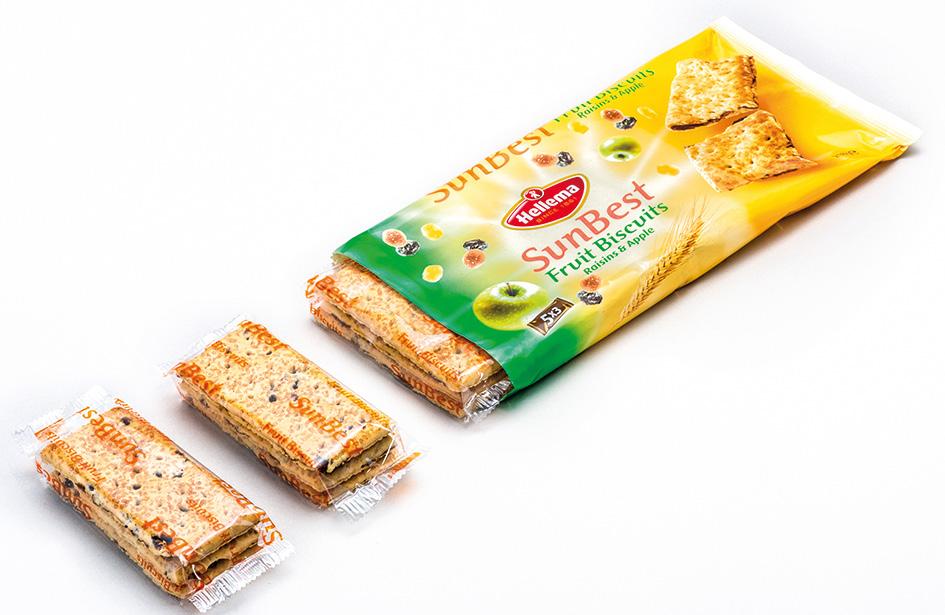
robots, the flow-wrapping unit and a quality control system. It makes it easy to switch between baked goods of different shapes and sizes as well as between different packaging formats and materials. For example, the Flowpacker can package baked goods directly from the oven, either individually, in groups or stacked into flowpacks, or place them in different formations into trays or U-boards before packaging them into flowpacks. Thanks to Schubert’s various advanced sealing technologies, manufacturers of baked goods also have the option of using extra-thick high-barrier films. The use of environmentally friendly paper-based films or recyclable monofilms is also possible with the exceptionally flexible flow-wrapping machine.
Responding to consumer demand with sustainable baked goods packaging
The topic of sustainability plays a key role for Schubert. To provide its customers with
the best possible advice, the packaging specialist has bundled its far-reaching expertise into its Packaging Perspectives programme. By providing consulting, packaging development
and research, the technology leader aims to actively support producers of baked goods along their sustainability journey. In practical terms, this means that the Schubert experts help with material selection and packaging design to develop a packaging solution that is both machine-compatible and environmentally friendly. By using Schubert’s modular, automated packaging machines, bakery businesses can not only respond flexibly to new requirements, but also produce sustainably and ideally position themselves for the future.
(Gerhard Schubert GmbH - Industriegebiet SüdostHofäckerstraße 7 - 74564 Crailsheim – Germany - Tel. +49 7951400-0 - e-mail: info@ gerhard-schubert.de - www. schubert.group)
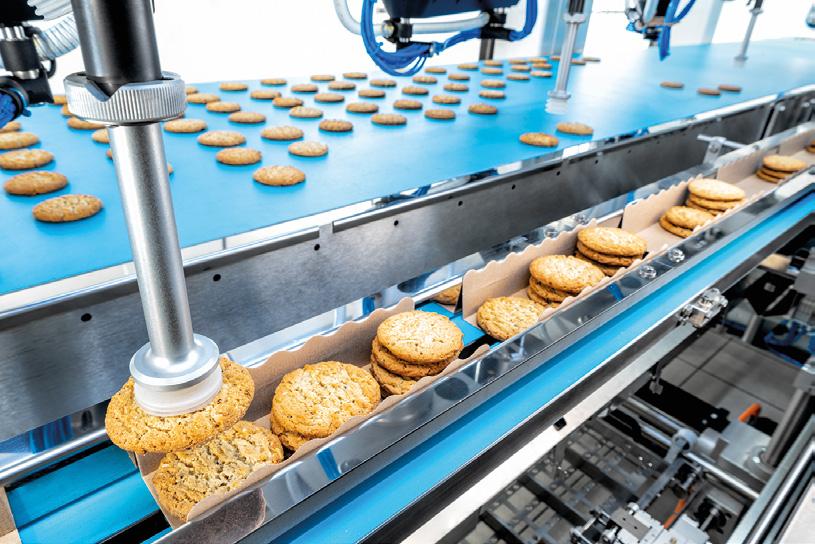
packaging equipment 42 italian food & packaging technology - cvi (2024) - march
The Flowpacker can also be used to pack biscuits into multipack flowpacks.
The Flowpacker packs baked goods directly from the oven either individually, in multiples or stacked into flowpacks, or places the baked goods in different formations in trays or U-boards before packing them into flowpacks.
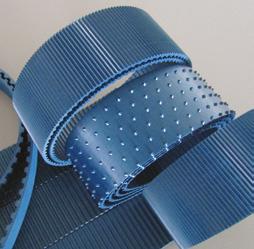



Food Safety is of paramount importance to protect consumers and their health. As Megadyne, we take up measures to continuously develop solutions improving the level of hygiene and safety in compliance with ISO 22000, EC 1935/2004, EU 10/2011 and FDA standards: Metal & X-Ray Timing Belts, MEGAFLEX FCM, MEGALINEAR and MEGAPOWER FC (Food Contact). Contact us to make your food production safer www.megadynegroup | info@megadynegroup.com


NO COMPROMISE IN FOOD SAFETY! WE MAKE YOU BUSINESS MOVE SUBSCRIBE Scan to watch the video
P.E. Labellers for Farchioni Olii
Twenty years of partnership: the relationship between the Farchioni Group and P.E. Labellers is a success story, grown in the name of collaboration and continuous innovation.
In 20 years of cooperation, Farchioni Olii has purchased 10 P.E. labelling machines installed in installed in the Gualdo Cattaneo and Giano facilities in Umbria (IT), consolidating a well-established partnership.
The common goal: flexibility and accuracy in labelling each bottle, to optimize the company’s production processes and put perfect products on the supermarket shelves.
Modular SL is the labelling solution that Farchioni continues to choose - ideal for its extreme versatility and on-board technological innovation. One of many special solutions is the automatic label feeder, which fully meets all the needs for non-stop production, with no downtime, making the operator’s job much easier and increasing the overall efficiency of the line.
Modular SL is an icon of flexibility: a multi-configuration and multi-technology machine, capable of incorporating interchangeable labelling units, with all the application technology on board. A single machine, in seven different diameters, with mobile or fixed labelling stations, and a production speed of up to 72,000 bph, ideal for the Food & Dairy sector, and also very popular in the Beverage, Wine & Spirits, HC & PC, Chemical and Pharma sectors.
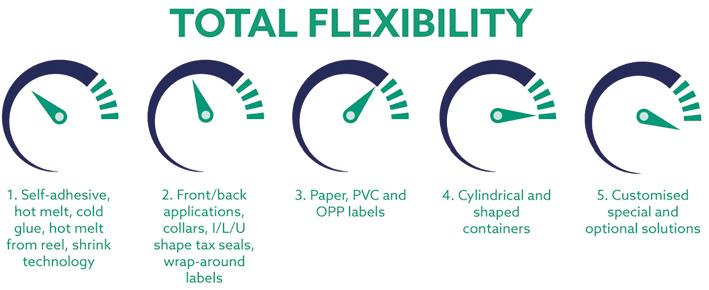
Farchioni and P.E. Labellers: the story of a partnership
“Well, it’s a fascinating story…”, says Riccardo Cerbini, Farchioni Olii Facility Director. “What impressed us for the first time about P.E. was the immense passion that everyone poured into what they did: we immediately felt on the same wave-
length because we have the same approach to our work. This is how we initiated the relationship between our companies and designed the first P.E. labeller for Farchioni. We ended up not buying six, but ten Modular SL models from then until now”.
“The relationship between Farchioni and P.E. Labellers developed in parallel - we grew together in a highly productive way, in an
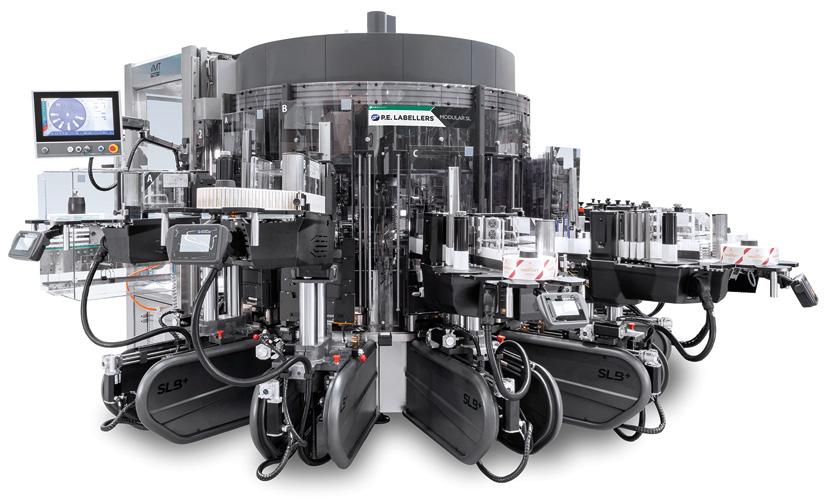
packaging equipment 44 italian food & packaging technology - cvi (2024) - march
Modular SL 1730 2022-1 (P.E. Labellers).
atmosphere of mutual trust. What impressed us from the very beginning about P.E. was the immense passion that everyone poured into what they did: we immediately felt on the same wavelength because we have the same approach to our work”.
The next steps: what do you expect from the future and how do you prepare for it?
“Overall, the Food sector is in a tough spot at the moment, especially when it comes to oil”, continues Riccardo Cerbini. “Nature basically does as it pleases... in the last two years, yields have been 40% less than average. We can expect a significant increase in costs, which unfortunately will also impact the end consumer. Our task will be to concentrate as far as possible on ensuring a constant, high quality raw material to be put on the market with continuous production.
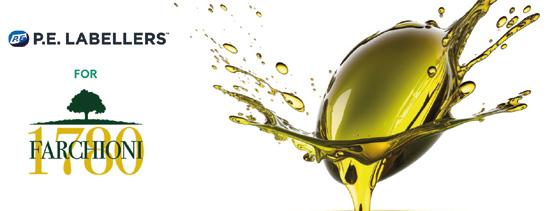
Farchioni has always stood for one thing: guaranteeing the end consumer a product that is excellent value for money. In order to do this, we have to be highly efficient, and, above all, extremely flexible, including in the investments that need to be made and the ability to manage warehouses and reduce stock. So, what we expect from the food market, at least over the next two years, is a response to the needs of largescale organised distribution.
Having a line in Farchioni now, that I believe is the fastest ever in the oil sector, effectively
reaching 20,000 bottles an hour, serves precisely this purpose and we will move increasingly in this direction, with the aim of promptly supplying the consumer with a product that is always fresh. To achieve these results, we will have to make further investments in technology, but we are ready. And we have the right partners to do this.”
(P.E. Labellers - Via Industria 56 - 46047 Porto MantovanoMN - Italy - Tel. +39 0376389311 - Fax +39 0376389411 - email: pelabellers@pelabellers.it - www. pelabellers.it)
Effect of packaging in preventing cholesterol autoxidation in milk chocolates
Non-enzymatic cholesterol oxidation products (COPs) are nowadays receiving increasing attention in food technology for their potential use as biomarkers of freshness and safety in raw materials and complex food matrices, as well as markers of cholesterol oxidation during the production and shelf-life of end products.
Italian Researchers reported the investigation of how long three prototype milk chocolates containing whole milk powders (WMPs) of increasing shelf-lives (i.e. 20, 120, and 180 days), could be safely stored in the market by
adopting the non-enzymatic COPs as a quality markers. In addition, the protective effect of two different primary packaging, sealed and unsealed ones, in mitigating the generation of non-enzymatic COPs in three prototype milk chocolates after 3, 6, 9, 12 months of shelf-life was assessed to simulate two real storage conditions. Quantifying oxysterols’ levels by mass spectrometry, the oxygen impermeable packaging (PLUS) resulted to significantly quench the non-enzymatic COPs production up to 34% as to that found in the same product but with unsealed standard packaging (STD).
This study published in PLoS ONE journal represents one practical application of non-enzymatic COPs as a reliable tool for corrective strategies to prevent food oxidation.
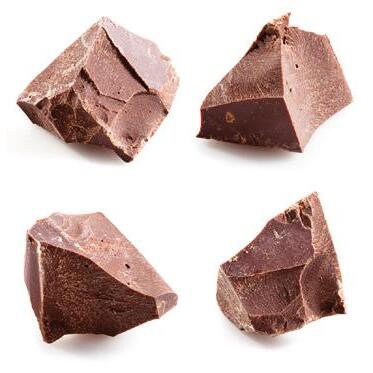
packaging equipment italian food & packaging technology - cvi (2024) - march 45
UVB treatments of packaged ready-to-eat salads
Ready-To-Eat (RTE) salads conveniently pre-prepared in bags can promote the intake of natural bioactive compounds, including antivirals such as quercetin. However, the content of these compounds in the species used for RTE salads is usually low due to limited solar UV exposure under tunnels and greenhouses in which they are usually cultivated.
To address this, Italian Researchers treated commercial fresh-cut lettuce (Lactuca sativa L.) and wild rocket (Diplotaxis tenuifolia L.) leaves using a narrow-band UVB lamp directly through sealed polypropylene bags during storage (5-6°C, 80% RH). The bagged leaf samples were kept under 20 micromol m-2 s-1 of white light with a 12 h photoperiod for 6 d. Half of the samples were additionally treated, 9 h d-1, during the first 3 d by UVB narrow-band lamps delivering 2.8-3.6 mumol m-2s-1 of UVB and 0.8-1.0 mumol m-2s-1 of UVA radiation. The effects of the UVB treatments on epidermal phenolics, chlorophyll and photosynthetic parameters were


monitored daily by non-destructive fluorescence sensors over a 6-d storage period. At the end of the experiment, destructive HPLC-DAD analysis of phenolics and photosynthetic pigments, antioxidant capacity assays and fresh weight loss determinations were conducted. The UVBtreatment increased the epidermal phenolics (EPhen) Index with respect to unirradiated controls, while not affecting chlorophyll and carotenoids levels as well as photosynthetic efficiency. For both species, the EPhen Index changes were detected 15 h after the first UVB application. Then, wild rocket responded faster than baby-leaf lettuce and reached the maximal phenolic level with less than 1/3 of the energy dose needed by lettuce. UVB-treated samples exhibited higher flavonoid concentrations (mainly quercetin derivatives) compared to controls (48-67% and 37-66% in lettuce and wild rocket, respectively). Leaf chlorophyll and carotenoid contents were not affected by both UVB treat-

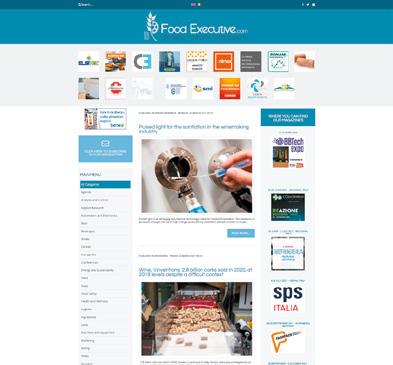
ment and storage. We proved, for the first time, that it is possible to treat RTE salad leaves using through-packaging UVB radiation and enhance their total phenolic and quercetin derivative contents. They also provided more insights concerning the dynamics of the UVB-elicitation of phenolic compounds in postharvest leaves.
The results published in Postharvest Biology and Technology journal are propaedeutic for the optimization of potential UVB-treatments; selection of the most efficient wavelengths, intensity, single/multiple doses and proposals for application in the food industry.
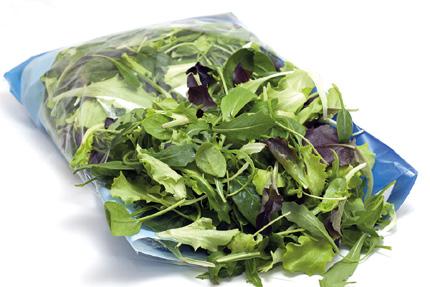
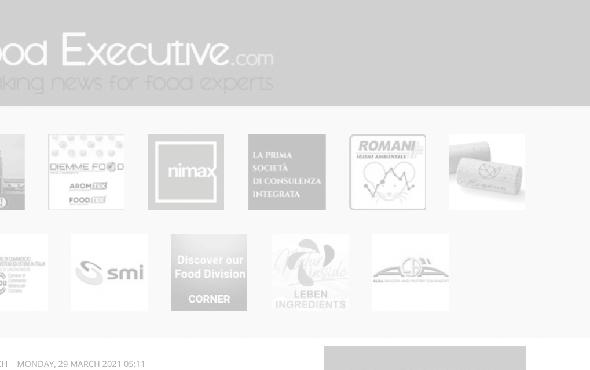
packaging equipment 46 italian food & packaging technology - cvi (2024) - march
+ NEWS + INFORMATION www.foodexecutive.com FOODEXECUTIVE 1-4.indd 4 31/03/21 16:32


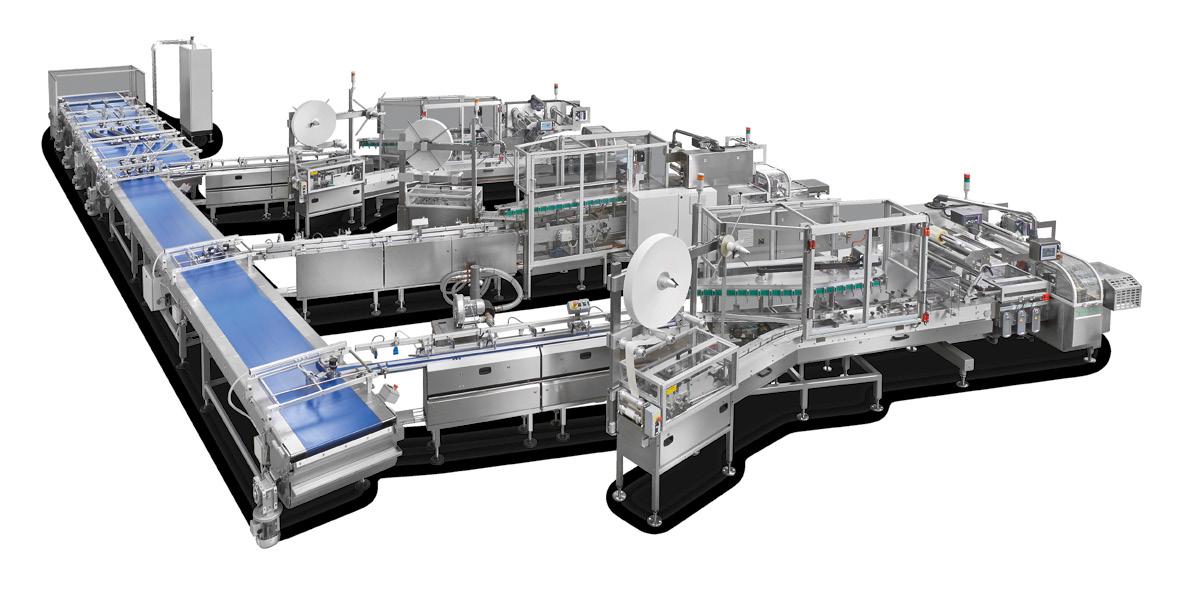
Are all ultra-processed foods linked to cancer and diabetes?
• A diet rich in ultra-processed foods is associated with the development of multiple chronic conditions, according to a new study.
• Particularly likely to lead to concurrent cancers, diabetes, and heart problems are animal-based ultra-processed foods and artificially and sugar-sweetened drinks.
• Although this study found no such link between ultra-processed foods such as breads, cereals, or plant-based alternatives, experts caution against their overconsumption.
• An issue with identifying ultra-processed foods is that they are typically categorized according to their degree of processing, with less emphasis on nutritional value.
The consumption of ultraprocessed foods has been linked to various individual chronic diseases such as cancer, diabetes, and cardiovascular disease. Now, a large study confirms that they
are also linked to comorbidities, or combinations of such diseases.
The study finds that there is a 9% increase in the likelihood of developing cardiovascular and cardiometabolic comorbidities
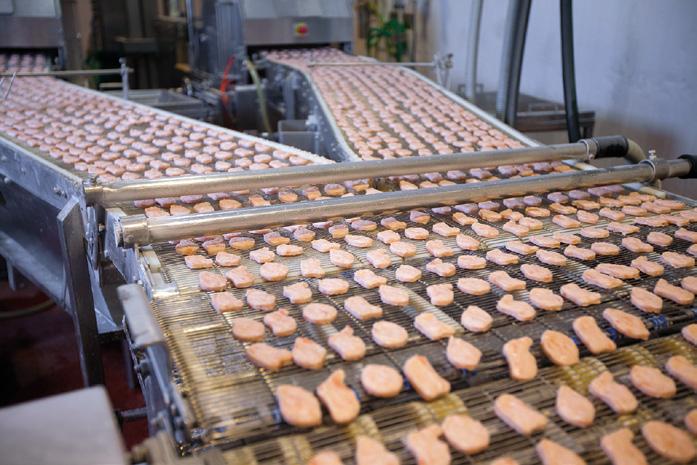
48 italian food & packaging technology - cvi (2024) - march NUTRITION
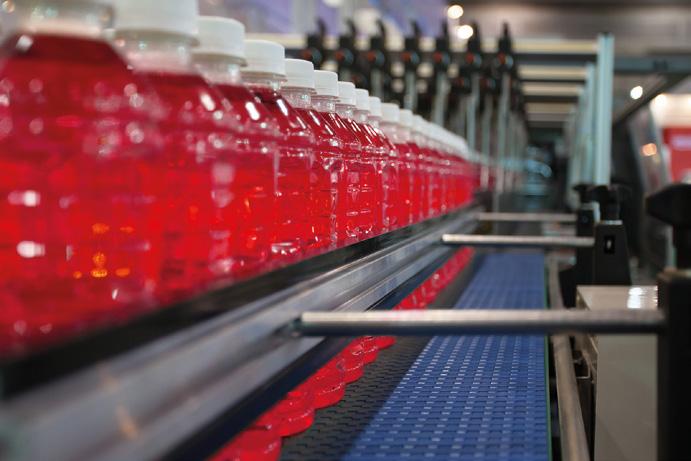
for those whose diet consists of a significant amount of ultra-processed foods. The greatest increase in risk, according to the study, was for animal-based products and artificially and sugar-sweetened beverages. The researchers found no similar association between ultra-processed breads and cereals, plant-based alternatives, and comorbidities.
The study is an analysis of data from the European Prospective Investigation into Cancer and Nutrition (EPIC). This is an ongoing prospective cohort study of associations between cancer and other diseases, and lifestyle, diet, genetic, and environmental risk factors.
For the new study, the researchers looked at data from 266,666 participants. The foods they ate were ranked based on their level of processing according to the NOVA index. There was a median 11.2 years of follow-up to track the development of chronic diseases.
The study is published in The Lancet Regional Health – Europe.
Processed vs. ultra-processed foods
There is no universal agreement on exactly what attributes define a problematically processed food. This is largely because most modern foods, unless sourced directly from the location in which they are grown, involve some measure of process-
ing. Processed foods may include such healthy food items as tofu, simple bread, canned tuna or beans, and cheese. However, it is ultra-processed foods, or UPFs, that are of greatest concern.
The standard embraced by most researchers is the NOVA index, developed by Carlos Monteiro and colleagues at the Sao Paolo University in Brazil.
The new study’s senior investigator, Dr. Heinz Freisling, scientist in nutrition and metabolism for the World Health Organization, explained how the index works: “NOVA classifies foods not according to their nutrient profile, but according to their degree of processing into four categories: fresh or minimally processed, culinary ingredients, processed, and ultra-processed.”
Michelle Routhenstein, preventive cardiology dietitian at EntirelyNourished.com, who was not involved in the study, described the final category as “foods that are made exclusively using a combination of industrial processes.” Since the degree of
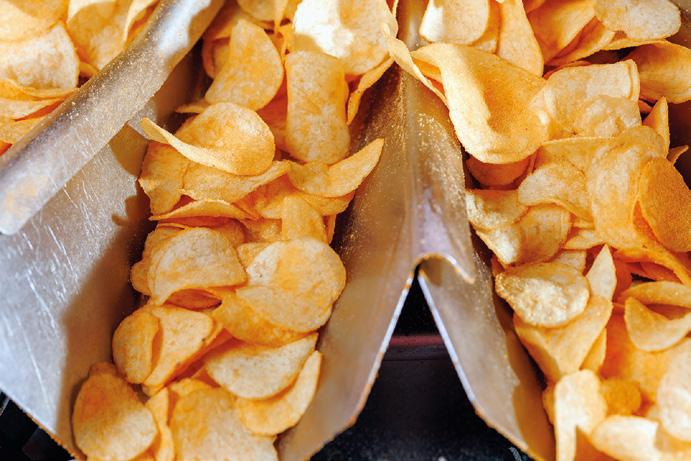
nutrition italian food & packaging technology - cvi (2024) - march 49
processing alone does not tell the entire story — ingredients matter as well — there remains room for personal opinions on the matter.
For Dr. Freisling, “[u]ltra-processed foods are foods that cannot be prepared at home because of a lack of both machinery needed for preparation, and ingredients that are characteristic
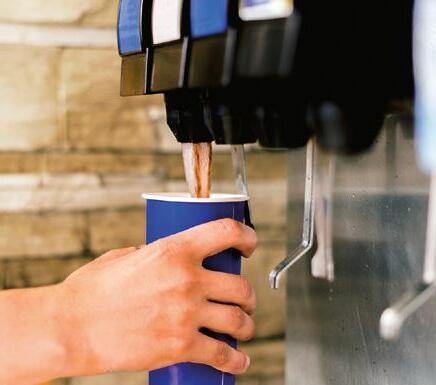
for ultraprocessing. Examples of such ingredients are colorants, artificial sweeteners, food preservatives, and more.”
How ultra-processed foods may cause comorbidities
Why might consuming ultra-processed foods result in comorbidities? “This is currently a hot topic of research because it is not yet clear why ultra-processed foods show this strong link with a wide range of conditions,” said Dr. Freisling.
He hypothesized that perhaps it has to do with the ready availability and lower cost of such foods to the consumer. Designed for flavor — and imperishability — people tend to over eat them. “For example, a simple boiled corn
cob is no competition to a bag of tortilla chips,” Dr. Freisling said. He also suggested additives, including artificial sweeteners, may play a role. “The pure lack of dietary fiber and the modified food matrix — the natural matrix or shape of a food at a microscopic level — could play an important role,” he added.
Routhenstein noted that processing methods themselves may also be responsible. She said that ultraprocessing methods create byproducts within the food that can promote disease.
“For example, advanced glycation end products (AGE) are formed as a byproduct of certain food productions, and it can lead to inflammation and oxidative stress, contributing negatively to a wide range of health conditions,” pointed out Routhenstein.
“AGE levels are highest per gram in ultra-processed foods that utilize dry heat, such as crackers, chips, and cookies,” she further noted.
Are breads, cereals, and plant-based alternatives healthier?
Although the study found no association between ultra-processed breads and cereals and plant-based alternatives, Dr. Freisling does not believe that means they should be considered a worthwhile component in one’s diet. “I do remain concerned because people consuming a diet with a high proportion of ultra-processed foods usually consume these foods across the board,” he said. Furthermore, while the study is concerned with comorbidities, such foods have been linked to individual chronic diseases in previous studies.
Healthier substitutes for ultra-processed foods
Routhenstein offered several easily prepared foods that can take the place of ultra-processed foods in one’s diet. “An easy swap you can make is changing fruit-flavored yogurts to making your own yogurt and fruit bowl,” said Routhenstein.
Another yogurt-related improvement would be to replace whey protein powder that contains emulsifiers, flavor enhancers, and isolates with ¾ cup of unflavored/unsweetened Greek yogurt. Routhenstein provided a few other tips, such as exchanging ultra-processed meat like bacon for a homemade tempeh and mushroom version.
Are some ultra-processed foods OK to eat?
“We showed that a risk factor — here a high consumption of ultra-processed foods — is not only linked to a higher risk of one severe disease, e.g., diabetes, but can increase the risk of [experiencing] a combination of diseases, known as multimorbidity,” said Dr. Freisling.
“Second,” he said, “I do think that it is important to communicate to the public that certain subgroups of ultraprocessed foods should be preferred over others. For example, plant-based vs. animal-based products.”
Routhenstein agreed with this second point, saying, “This sheds light on the need to assess nutrient value like fiber in offsetting the detrimental effects of ultra-processed foods as defined by the NOVA classification scale.”
www.medicalnewstoday.com
nutrition 50 italian food & packaging technology - cvi (2024) - march
Natural food colors revolutionizing the palate: unleashing the potential of natural ingredients In the evolving food industry
Natural food colors are pigments derived from natural sources such as fruits, vegetables, plants, and minerals. They are widely used in the food and beverages industry by manufacturers to add color to food items or drinks. These natural food colors are available in liquid and powdered forms. Consumers are increasingly turning towards natural and organic ingredients in food colors for a better lifestyle and to minimize the risk of diseases that are caused by to consumption of artificial food colors.
According to the latest report by Allied Market Research agency, there has been a significant surge in demand for natural food ingredients, including natural food colors, in recent years. Consumers are increasingly looking for healthier and more sustainable food options. An upsurge in demand for natural colors from various end-use industries such as processed food, frozen food, dairy food, and beverages is expected to have a positive impact on the industry.
Evolving consumer preferences and growing demands play a crucial role in shaping the natural food colors market. Increased health consciousness, awareness about the side effects of artificial additives, and a desire for clean-label products are expected to fuel the demand for natural food colors over the coming years. On the other hand, the regulatory framework governing food colorants is becoming a significant factor in the natural food colors business. Regulations vary across countries and regions, with specific standards and guidelines for the use of natural colorants. The manufacturers are focusing on meeting consumer demand by meeting evolving regulations to ensure legal compliance and consumer trust.
Advances in technology and extraction methods have significantly impacted the natural food colors industry. Innovations such as improved extraction techniques, novel sources of natural colorants, and sustainable pro-

duction methods have expanded the range of available options and improved the quality of natural food colors. Solvent extraction, cold-press extraction, and steam distillation are the most popular extraction techniques among the manufacturers.
Europe is one of the leading regions for the natural food ingredients & additives market.
According to the report published by the Center for the Promotion of Imports- Ministry of Foreign Affairs 2022, the UK is a leading importer of natural food ingredients, such as colorants and oleoresins.
With high disposable income, the demand for natural foods among the European consumers is expected to rise, thereby boosting the growth of the natural food colors market. Germany is a major country contributing significantly to the market growth in the region. Russia, France, and Italy are other potential markets in Europe. Greater demand for naturally processed food and beverages has been experienced by the retail stores in Europe.
According to the data published by the Food and Beverage News India 2023, the plantbased food ingredients market in France was valued at $570 million which is expected to reach near $1,000 million by the end of 2026. Some natural food specialists presnt in the country include Denn’s Biomarkt, Bio Company, and Alnatura.
nutrition italian food & packaging technology - cvi (2024) - march 51
Factors expected to strengthen natural food colors business in developing Countries
• Transparency during the sourcing of raw materials
• Availability of safe products to the end users
• Insights into products and their manufacturing processes The natural food colors market was valued at $1,308.3 million in 2021 and is estimated to reach $3,865.9 million by 2031, exhibiting a CAGR of 10.9% from 2022 to 2031.
COVID-19 Impact on the Natural Food Colors Market
The outbreak of COVID-19 caused poor logistics, traffic control, and restrictions on public movement leading to supply disruptions. According to the World Trade Organization (WTO) 2021, the global merchandise trades

declined by nearly 32% in 2020, which was a steeper decline than the 9% contraction recorded during the global financial crises in 2008-2009. Major importers such as the UK, the U.S., Germany, and others, recorded a decline in sales of natural food colors. The WTO also reported that the disrupted supply chain and trade management are expected to normalize over the next couple of years.
Natural food ingredients, such as natural food colors, are becoming mainstream products among consumers. Food manufacturers are increasingly utilizing them to offer a desired natural appeal to the consumers in the market. The manufacturers are analyzing the factors that are impacting the consumers’ buying behavior due to the impact of COVID-19 to cater to the evolving demand for natural food colors in the market. www.alliedmarketresearch.com
Common food preservative has unexpected effects on the gut microbiome
Food manufacturers often add preservatives to food products to keep them fresh. The purpose of these preservatives is to kill microbes that could break down and otherwise spoil the food. Common additives like sugar, salt, vinegar and alcohol have been used as preservatives for centuries, but modern-day food labels now reveal more unfamiliar ingredients such as sodium benzoate, calcium propionate, and potassium sorbate.
Bacteria produce chemicals called bacteriocins to kill micro-
bial competitors. These chemicals can serve as natural preservatives by killing potentially dangerous pathogens in food. Lanthipeptides, a class of bacteriocins with especially potent antimicrobial properties, are widely used by the food industry and have become known as “lantibiotics” (a scientific portmanteau of lanthipeptide and antibiotics).
Despite their widespread use, however, little is known about how these lantibiotics affect the gut microbiomes of people who
consume them in food. Microbes in the gut live in a delicate balance, and commensal bacteria provide important benefits to the body by breaking down nutrients, producing metabolites, and – importantly – protecting against pathogens. If too many commensals are indiscriminately killed off by antimicrobial food preservatives, opportunistic pathogenic bacteria might take their place and wreak havoc – a result no better than eating contaminated food in the first place.
nutrition 52 italian food & packaging technology - cvi (2024) - march
Effects on good and bad bacteria
A new study published in ACS Chemical Biology by scientists from the University of Chicago found that one of the most common classes of lantibiotics has potent effects both against pathogens and against the commensal gut bacteria that keep us healthy.
Nisin is a popular lantibiotic used in everything from beer and sausage to cheese and dipping sauces. It is produced by bacteria that live in the mammary glands of cows, but microbes in the human gut produce similar lantibiotics too. Zhenrun “Jerry” Zhang, Ph.D., a postdoctoral scholar in the lab of Eric Pamer, MD, the Donald F. Steiner Professor of Medicine and Director of the Duchossois Family Institute at UChicago, wanted to study the impact of such naturally-produced lantibiotics on commensal gut bacteria.
“Nisin is, in essence, an antibiotic that has been added to our food for a long time, but how it might impact our gut microbes is not well studied,” Zhang said. “Even though it might be very effective in preventing food contamination, it might also have a greater impact on our human gut microbes.”
He and his colleagues mined a public database of human gut bacteria genomes and identified genes for producing six different gut-derived lantibiotics that closely resemble nisin, four of which were new. Then, in collaboration with Wilfred A. van der Donk, Ph.D., the Richard E. Heckert Endowed Chair in Chemistry at the University of Illinois Urbana-Champaign, they
produced versions of these lantibiotics to test their effects on both pathogens and commensal gut bacteria. The researchers found that while the different lantibiotics had varying effects, they killed pathogens and commensal bacteria alike.
“This study is one of the first to show that gut commensals are susceptible to lantibiotics, and are sometimes more sensitive than pathogens,” Zhang said. “With the levels of lantibiotics currently present in food, it’s very probable that they might impact our gut health as well.”
Harnessing the power of lantibiotics
Zhang and his team also studied the structure of peptides in the lantibiotics to better un-
derstand their activity, in the interest of learning how to use their antimicrobial properties for good. For example, in another study, the Pamer lab showed that a consortium of four microbes, including one that produces lantibiotics, help protect mice against antibiotic-resistant Enterococcus infections. They are also studying the prevalence of lantibiotic-resistant genes across different populations of people to better understand how such bacteria can colonize the gut under different conditions and diets.
“It seems that lantibiotics and lantibiotic-producing bacteria are not always good for health, so we are looking for ways to counter the potential bad influence while taking advantage of their more beneficial antimicrobial properties,” Zhang said.

nutrition italian food & packaging technology - cvi (2024) - march 53
Use of cassava flour in the elaboration of ice cream
The objective of A Cuban research published in Ciencia y Tecnologia de Alimentos. (32, (3): 48-52,2022) was to evaluate the behavior of cassava flour in the production of cream ice cream 40°C, which corresponds to the initial mixing phase, was defined as the addition temperature of the cassava flour.
Two levels of flour 1 and 1.5% and three of stabilizer 0.25, 0.35 and 0.45% were considered. The control variables were the fat content and total solids, and the response variables were
the Brookfield viscosity of the mixture, the overrun in the ice creams, together with the sensory evaluation of the attributes of the texture and the global sensory quality and melting. The established physicochemical and microbiological analyzes were carried out on the selected formulation, defining the sensory quality by means of an evaluative scale of 20 points.
The ice cream developed from the combination of 1.5% cassava flour and 0.35% stabilizer presented adequate microbiological
Ingredient from the fermentation of brewer’s spent grain liquids
Brewer’s spent grain (BSG) is an abundant brewing by-product, but a short shelf life limits its use. A rotary drum press can separate BSG into a solid and a liquid fraction (BSG liquid) that contains sugars.
Danish Researchers utilized propionic acid producing bacteria (PAB) strains from the family Propionibacteriaceae (DSM 20270, 20272, 20274, 106790) were screened for organic acids


and compositional characteristics, a melting of 33.8%/0.5 h, and 100% of excess performance (overrun). The score obtained in the sensory evaluation allowed obtaining a qualitative evaluation of excellent.
formation from BSG liquid in three fermentation setups: A single-step fermentation, a two-step fermentation with Lactiplantibacillus plantarum (NFICC 27) followed by PAB, and a co-culture of PAB with L. plantarum. The two-step fermentation produced 9.5g/L propionic acid and 5.4g/L acetic acid. GC-MS analysis of the fermented BSG liquid showed a decrease in off-flavours and an increase in compounds with fruity, chocolate and caramel notes. The fermented BSG liquid also had antimicrobial activity.
Fermentation of BSG liquid may therefore be a suitable means of creating a clean label food ingredient with long shelf life. These results were published in LWT - Food Science and Technology journal.
nutrition 54 italian food & packaging technology - cvi (2024) - march


THE PROFESSIONAL TOOLS FOR THE BEST INFORMATION www.chiriottieditori.com www.foodexecutive.com
RESEARCH
Influence of pre-baking and frozen storage on the quality of a multi-seed bread
Today’s tendency is to prepare baking products by replacing wheat flour with wholemeal flours, and submitting them to preparation processes so they can be eaten at any time, to guarantee their nutritional and organoleptic properties, such as high-value nutritional food, and to extend the shelf life of the product, for more demanding consumers. A Spanish work’s originality is shown in its holistic exploration of innovative baking practices, its unique approach regarding preservation through prebaking/ freezing/storage, and its meticulous examination of nutritional and
technofunctional attributes of an optimal formulation with innovative ingredients.
This work published in LWTFood Science and Technology journal studies the behaviour of easily made, multiseed bread made with quinoa, chia and amaranth flours to prepare and eat by applying a prebaking/freezing/ storage process. The results were compared to the control product made only with wheat flour, which was processed under the same conditions. The technofunctional and nutritional properties (mineral bioavailability, amino acids

content and fatty acids profile), and the prebaking-freezing effect on them, were investigated. Essential amino acids (EAAs; i.e., lysine, valine, leucine) were not lost during the frozen storage process, and respectively exceeded the control product by 50%, 10% and 5%. The difference in colour (DELTAE*) between the control and the multiseed products was below 5 after baking/ storage, which indicates that a colour change could not be perceived by consumers. After freezes storage, amylopectin retrogradation enthalpy was up to 33% lower than in the control sample, possibly due to the action of polyunsaturated fatty acids and the soluble fibre content present in the multiseed product.
This bread formulation could meet adults’ nutritional requirements regarding calcium and diet fibre with a daily intake of 100 g.
56 italian food & packaging technology - cvi (2024) - march
Upcycling soy processing waste for fat replacement in sweet bread
Okara is the main waste of soy processing and represents a large economic and environmental burden. Nevertheless, the fibre and protein content of okara supports the upcycling of this critical waste. An Italian study published in the Journal of the Science of Food and Agriculture aimed at assessing the potentialities of okara as an innovative oil-structuring ingredient.
Structured emulsions containing up to 520g oil kg-1 and having oil holding capacity higher than 75% were prepared by high-shear mixing of okara with liquid oil. Microstructural analysis showed that the oil phase was evenly distributed in the okara matrix, probably due to the emulsifica-
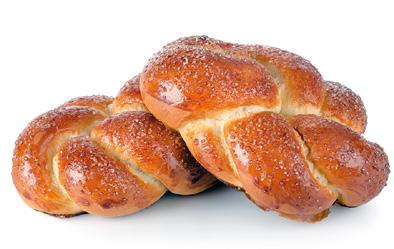
tion ability of the okara fibre-protein network. The performance of okara structured emulsions as palm margarine replacer were tested in the preparation of sweet bread. Okara emulsions (500g oil kg-1) resulted not only in a significant reduction of saturated fatty acids (>50%), but also in an increased protein and fibre content. Compared to the use of liquid oil solely, okara emulsions
Replacement of nitrates/nitrites in salami by plant extracts
Salami is a cured sausage consisting of fermented and airdried meat obtained from a mixture of meat and fat with spices and other ingredients. Excessive processed meat consumption is negatively considered because of its high fat and salt contents and few bioactive molecules. Notwithstanding, salami is largely consumed, and there is a strong interest to produce better and healthier products by substituting nitrites and nitrates with natural extracts.
An Italian work published in Food Bioscience journal, pro-
duced four different salami, two controls including nitrates and two alternative preparations where nitrates were substituted with plant extract and ascorbic acid. The products were in vitro digested with the INFOGEST protocol to simulate the oro-gastro-duodenal phase and in vitro fermented with MICODE model to simulate the colon phase. Samples were analyzed by microbiomics and metabolomics approaches to study the changes in bacterial populations
allowed reducing the oil released from bread loaf. Bread containing okara emulsion also presented physical and sensory properties similar to those of palm margarine bread, the only exception being a more perceivable oiliness and rancid defect, which are, however, easily preventable by applying appropriate formulation strategies.
In conclusion, he use of okara as innovative ingredient for oil structuring would answer the current demand for sustainable heathy diets, based on clean-label foods with low-saturated fat content, and increased protein and fibre supply. This approach would also allow the complete upcycling of this critical waste.

and in metabolites production. The results showed that the clean-label formulations promote a general eubiosis of the intestinal microbiota, including
research italian food & packaging technology - cvi (2024) - march 57
favorable F/B ratio, the proliferation of beneficial microbial taxa (Bifidobacteriaceae), and reduction of negative microbial populations (Enterobacteriaceae). Volatilome analysis highlighted a marked production of beneficial molecules, including ace-
tate, propionate and butyrate, and a reduction in host negative molecules such as phenol and p-cresol.
The results tell that the plant extracts could be used to replace nitrates, because the features obtained are comparable
Extraction technologies to produce food-grade hop extracts
Hop extracts represent a natural alternative to synthetic food additives because of their high content of bitter acids and volatile organic compounds (VOCs) with bittering, flavoring, and antimicrobial properties. However, broader uses of hop extracts as natural techno-functional ingredients rely on the identification of sustainable and affordable extraction technologies allowing to diversify the processes and produce extracts characterized by different compositions and, consequently, qualitative properties. Thus, an Italian study published in the Journal of Food Science is aimed to evaluate and compare
the effect of innovative and conventional extraction methods on the bitter acids content and VOCs pattern of food-grade ethanolic hop extracts for food applications.
Innovative extractions were carried out by using two ultrasound systems (a laboratory bath [US] and a high-power ultrasound bath [HPUS]), and a high-pressure industrial process (high hydrostatic pressure [HHP]). Conventional extractions (CONV) were performed under dynamic maceration at 25° and 60°C; for ultrasound and conventional methods, the effect of the extraction time was also investi-
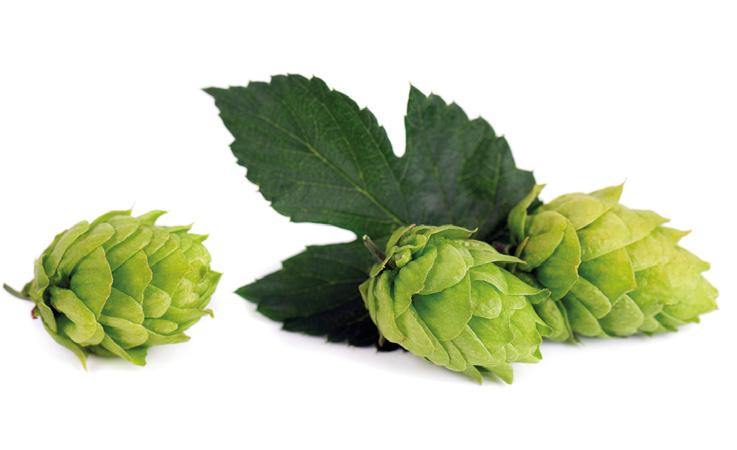
to those of controls. This work could represent an encouraging starting point for the processed meat industry for the development of clean-label formulations aimed at reducing the negative impact of these products on consumers.
gated. Among the extracts, the highest and lowest content of bitter acids was found in CONV 60°C extracts, and HHP and CONV 25°C extracts, respectively. Of the 34 VOCs identified in dry hops, ~24 compounds were found in US, HPUS and CONV extracts, while only 18 were found in HHP. CONV extractions showed higher selectivity for sesquiterpenes, while US and HPUS showed higher selectivity for esters and monoterpenes. Hierarchical cluster analysis (HCA) and partial least squares-discriminant analysis (PLS-DA) allowed classifying hop extracts based on the extraction methods and also allowed highlighting the technological conditions to produce hop extracts with specific techno-functional and flavoring properties.
The study showed that different extraction methods can lead to hop products with varying sensory and functional properties. By selecting the right extraction method, companies can produce hop extracts with specific compositions that meet their needs for clean label and sustainable food products, as well as new edible packaging or coatings.
research 58 italian food & packaging technology - cvi (2024) - march
Natural whey starter on cheese whey
Fermentation is a promising solution to valorize cheese whey, the main by-product of the dairy industry. In Parmigiano Reggiano cheese production, natural whey starter (NWS), an undefined community of thermophilic lactic acid bacteria, is obtained from the previous day residual whey through incubation at gradually decreasing temperature after curd cooking. The aim of this Italian study published in the Fermentation journal was to investigate the effect of fermentation regime (spontaneous (S) and NWS-inoculated (I-NWS)) on biofunctionalities and release of bioactive peptides during whey fermentation.
In S and I-NWS trials proteolysis reached a peak after 24 h, which corresponded to the drop out in pH and the maximum increase in lactic acid. Biological activities increased as a function of fermentation time. NWS inoculum positively affected antioxidant activity, whilst S overcame I-NWS in angiotensin-converting
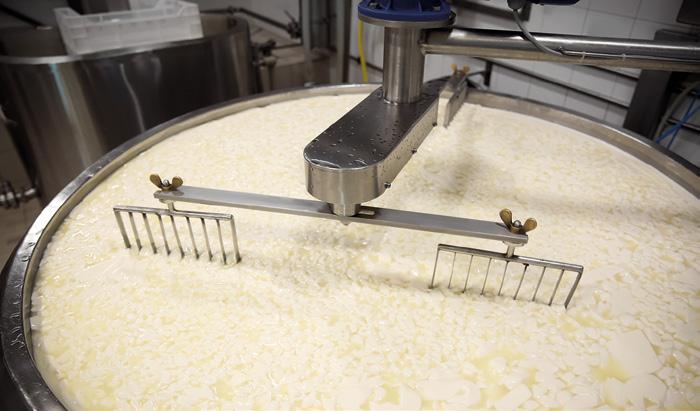
enzyme (ACE) and DPP-IV (dipeptidyl peptidase IV) inhibitory activities. Peptidomics revealed more than 400 peptides, mainly derived from beta-casein, kappa-casein, and alpha-lactalbumin. Among them, 49 were bioactive and 21 were ACE-inhibitors. Semiquantitative analysis strongly correlated ACE-inhibitory activity with the sum of the peptide abundance of ACE-inhibitory peptides. In both samples, lac-
totripeptide isoleucine-proline-proline (IPP) was higher than valine-proline-proline (VPP), with the highest content in S after 24 h of fermentation.
In conclusion, ther Italian Researchers demonstrated the ability of whey endogenous microbiota and NWS to extensively hydrolyze whey proteins, promoting the release of bioactive peptides and improving protein digestibility.
Improvement of Robusta coffee aroma by treated spent coffee grounds
Spent coffee grounds (SCG) are by-products obtained from the industrial process of instant coffee production or alternatively after brewing of coffee at the point of consumption. This solid residue represents one of the largest waste materials worldwide, making this fraction a rational target for valorization.
The composition of SCG varies significantly depending on the brewing and extraction methods. However, this by-product is mainly composed of cellulose, hemicellulose polysaccharides and lipids.
Swiss Researchers reported in Food Research International journal on the enzymatic hydrolysis of industrial SCG by the use
of a combination of specific carbohydrate active enzymes, enabling sugar extraction yield of 74.3 %. The generated sugar-rich extract, primarily composed of glucose (8.41 ±1.00 % of total SCG mass) and mannose (2.88 ±0.25 % of total SCG mass), is separated from hydrolyzed grounds and soaked with green coffee. After drying
research italian food & packaging technology - cvi (2024) - march 59

and roasting, the coffee soaked with SCG enzymatic extract displayed lower earthy, burnt and rubbery notes as well as smoother and more acidic notes in the flavor profile as compared to untreated reference. Aroma profiling performed by SPME-GC-MS corroborated the sensorial effect, with a 2-fold increase in the generation of sugar-derived molecules such
as Strecker aldehydes and diketones after soaking and roasting and a 45 % and respectively 37 % reduction in phenolic compounds and pyrazines.
This novel technology could represent an innovative in situ valorization stream for the coffee industry, coupled with sensory improvement of the final cup.
Enhancing zein-starch dough and bread properties by addition of hydrocolloids
Similar to gluten, zein can form a viscoelastic network upon hydration and shear. This makes zein a promising protein to develop gluten-free bakery products. In a Canadian study published in Food Hydrocolloids journal, the effect of addition of different hydrocolloids (hydroxypropyl methylcellulose (HPMC), guar and xanthan gum), and the inclu-
sion of pregelatinized starch (PG starch) and lactic acid (LA) on zein-corn starch dough and bread properties was examined.
The addition of HPMC, and to a lesser extent guar gum, significantly changed the viscoelastic zein dough properties and resulted in bread samples with
improved loaf volume and sensory properties. Scanning electron microscopy revealed the formation of a continuous fine foam-like structure in the zeinstarch dough when HPMC and guar gum were added. This finer structure translated in a lower dough stiffness and resistance to deformation, and a higher degree of deformation characterized by lower complex moduli and increased creep compliance values. Xanthan gum addition, conversely, had an adverse effect on zein bread loaf volume which was attributed to potential weak repulsion between xanthan and zein molecules. In addition, the amount of alpha-helix and beta-sheet secondary structures in bread samples was altered upon hydrocolloid and PG starch addition and played a role in bread crumb hardness. Overall, the zein bread with HPMC showed textural properties most similar to gluten bread.
This research sheds light on different structure levels of zeinbased gluten-free recipes as affected by inclusion of hydrocolloids, PG starch and LA, and provides a sound basis for the rational development of zein-based gluten-free breads.
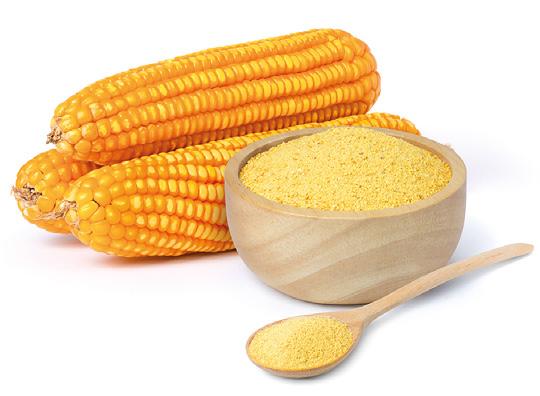
research 60 italian food & packaging technology - cvi (2024) - march

























Conferences









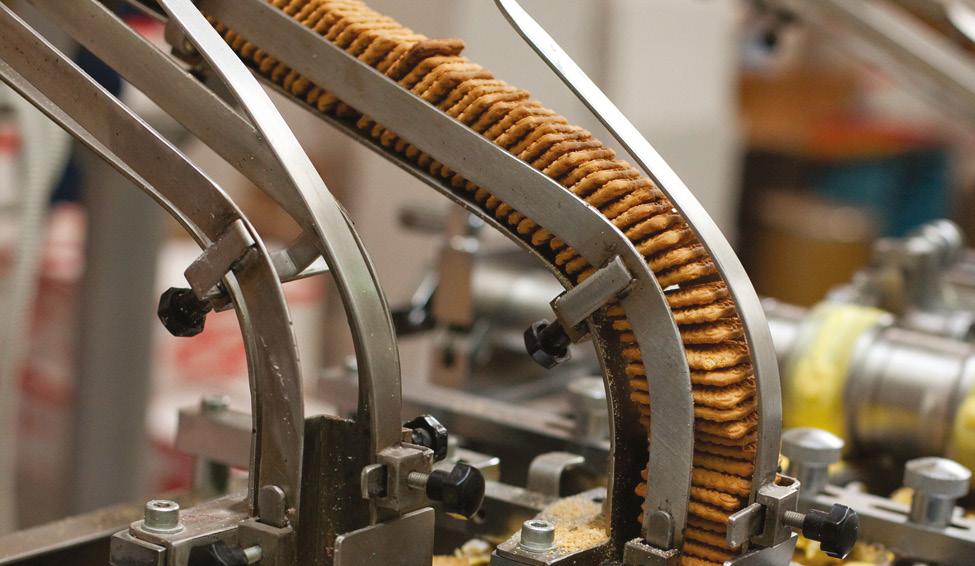
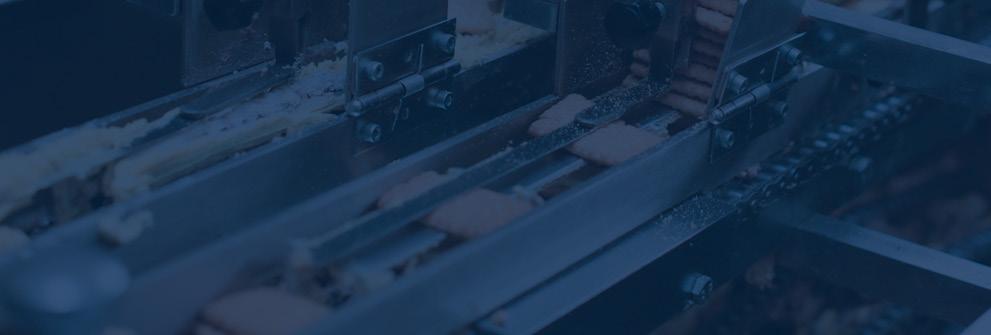

Agenda AITA Analysis and Control
Applied Research
Companies
Automation and Electronics Beer Beverages Books Cereals
Sustainability
Wellness
Ingredients
Machines and Equipment Marketing Milling News Nutrition Packaging Pasta Soft Drinks Spirits Wine www.foodexecutive.com the latest news on the food&beverage world
Energy and
Feed Food Food Safety Health and
Hygiene
Laws
Distillo lands at Simei 2024: together at Milano in November
Simei is enhanced with new themes and content thanks to the partnership with Distillo, a trade fair dedicated to micro-distillery equipment that will hold its third edition at the International Winemaking and Bottling Machinery Exhibition, scheduled from 12 to 15 November at Fiera Milano.
“We are celebrating our 30th edition with the entry of a growing and strategic event for an increasingly interesting product sector – commented Paolo
Castelletti, administration manager of the Unione Italiana Vini, which organises the event –. Distillo brings a new conference area and top-level content to Fiera Milano, a partnership that we believe SIMEI can use with a view to business development and networking, broadening its scope to the entire beverage technology sector “.
For Claudio Riva and Davide Terziotti, owners of Craft Distilling and co-founders of Distillo: “After two editions that enabled us to

assess the distillation market, in particular with the 2023 edition that showed how the sector is now mature and attractive for traders and future foreign distillers too, we thought that the natural progression was to find a partner. A partner that was not only a leader in international trade fairs, but one with great skills in the sector that would also be able to support the development of the market”. Organised by Craft Distilling, the first micro-distillery consulting company in Italy, Distillo debuted in 2022. It is now the reference event for the entire Mediterranean area for the world of artisanal distillation, a growing phenomenon of particular interest in the world of beverages.
60 years after its debut, SIMEI represents the leading event for machinery for winemaking and the bottling of beverages. With over 30,000 attendees registered in the 2022 edition, the fair is increasingly the reference event for a crucial sector – with a high technological and internationalisation rate – of the Made in Italy brand worth more than 3 billion euros, a moment for analysis and exchange on the state of the art and sector policies.
www.simei.it
www.distillo.it
62 italian food & packaging technology - cvi (2024) - march
NEWS
INTERNATIONAL EVENTS IN ITALY
14-17 April 2024 - Verona: Sol&Agrifood, Italian food and olive oil show - www.vinitaly.com
14-17 April 2024 - Verona: Vinitaly, Italian wine show - www.vinitaly.com
19-21 April 2024 - Bologna: Cosmofarma, functional and nutraceutical exhibition - www.cosmofarma.com
7-10 May 2024 - Parma: Cibus, food show - www.cibus.it
8-10 May 2024 - Rimini: Macfrut, fruit and vegetable processing exhibition – www.macfrut.com
21-23 May 2024 - Milano: Packaging Première, luxury packaging show - www.packagingpremiere.it
28-30 May 2024 - Parma: SPS Italia, automation and digital show - www.spsitalia.it
6-7 June 2024 - Parma: Solids, powder and bulk processing show - www.solids-parma.de
5-8 September 2024 - Bologna: Sana, organic food show - www.sana.it
8-12 September 2024 - Rimini: IUFOST, world food science congress - www.iufost.org
12-15 November 2024 - Milano: Simei, beverage and wine industry show - www.simei.it
18-22 January 2025 - Rimini: Sigep, confectionery, pastry and ice cream show - www.sigep.it
8-11 May 2025 - Milano: Tuttofood, food show - www.tuttofood.it
27-30 May 2025 - Milano: Ipack-Ima, packaging, food processing and pasta show - www.ipackima.com
17-21 October 2025 - Milano: Host, hospitality show – www.host.fieramilano.it
28-29 October 2025 - Parma: CibusTec Forum, food processing forum - www.cibustec.it
27-30 October 2026 - Parma: CibusTec, food processing show - www.cibustec.it






















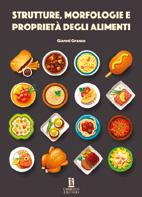




















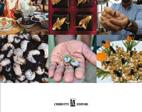












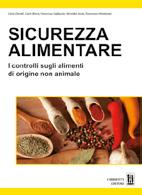
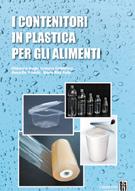
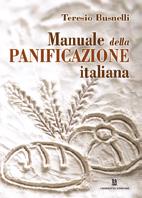

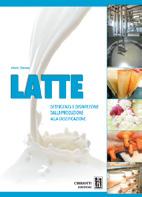






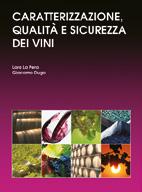


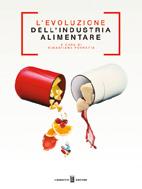


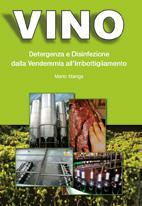




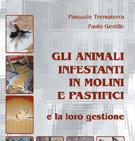
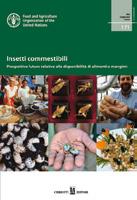







news italian food & packaging technology - cvi (2024) - march 63
shop.chiriottieditori.it RIEMPITIVO LIBRI 2023 1-2_new.indd 1 02/02/23 10:27







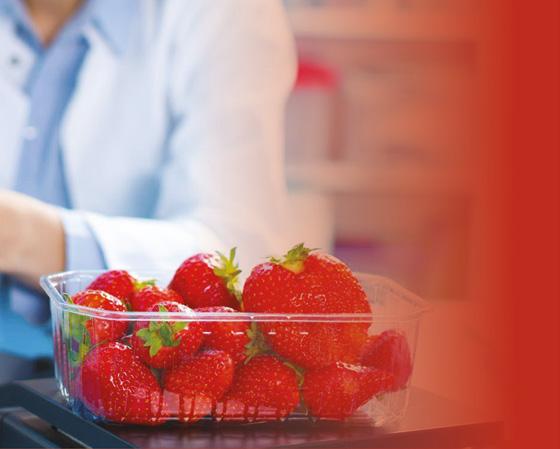
64 italian food & packaging technology - cvi (2024) - march Company directory Chiriotti Editori - Pinerolo - www.chiriottieditori.it 55 FoodExecutive - Pinerolo - www.foodexecutive.com .......................... 61 General System Pack - Schio - www.gsp.it .......................................... 47 Gerhard Schubert - Crailsheim (D) - www.schubert.group 33 IFP Packaging - Schio - www.ifppackaging.it....................................... 13 Italo Danioni - Milano - www.danioni.it ................................................ 25 Megadyne - Mathi - www.megadynegroup.com 43 P.E. Labellers - Porto Mantovano - www.pelabellers.com cover 2 Pinco-SA - Stabio (CH) - www.pinco-sa.com ................................cover 3 Sarp - Castelfranco Veneto – www.sarp.it 29 Tecno 3 - Corneliano d’Alba - www.tecno-3.it cover 1 Tecno Pack - Schio - www.tecnopackspa.it ...................................cover4 Ulma Packaging - Gragnano Trebbiense - www.ulmapackaging.it .... 21 Wolhfarth - Sordio - www.wolhfarth.it 17 Sarp 22 Emilos ................................................................................. 23 Tecno3 24 SMI Group 36 Schubert ............................................................................ 40 P.E. Labellers 44 Advertiser index www.chiriottieditori.it/en/ VISIT OUR SITE SUBSCRIBE TO OUR NEWSLETTER AND TO OUR SOCIAL MEDIA, WE WILL KEEP YOU INFORMED SITO CHIED 2018 1-2.indd 2 16/05/18 12:19


